For the last 60 years, the Tibetan Government-in-Exile has exploited, abused, marginalised and persecuted their people. For the first time in six decades, since the Tibetans first entered a life in exile, we are seeing more and more examples of ordinary Tibetans speaking up against this exploitation. In years gone past, Tibetans would never have dared to voice their objections to the leadership. To do so would have been tantamount to treason, and seen as a betrayal and ultimate disloyalty to His Holiness the Dalai Lama and the Tibetan cause (whatever that may be).
60 years of exploitation however, have led to a growing number of people willing to express their frustrations. As the younger generation of Tibetans become more exposed to different ways of thinking, and experience different cultures and styles of government, they are starting to see that the way their own leadership operates is not in the best interests of their people. This is because they now have something to compare the Tibetan leadership against, for example the democratic governments of America and Switzerland.
Below we have compiled for you some examples of the ways in which ordinary Tibetans have expressed their dissatisfaction with the current state of Tibetan society, and the different concerns that they have voiced. It is a cross-section and sampling of their concerns, their methods and the challenges they face in voicing their opinions.
Should people living in a free and democratic society like India (where the majority of Tibetans reside) fear speaking up against their leadership? Should they hesitate and think twice about the repercussions of voicing their own opinions, which they are perfectly entitled to do? What kind of democracy fosters such a culture of fear?
Unless the Tibetan leadership has a major shift in their attitude, they should be very concerned about losing the loyalty of their people. Everyone has a limit and everyone’s patience can only go so far and as the examples below show, maybe 60 years of manipulating their people is starting to become more than many can bear.
1. Tenzin Sherab Mimicking Professor Samdhong Rinpoche
Samdhong Rinpoche was the first “voted” Prime Minister of the Tibetan Government-in-Exile. In his position as a Prime Minister for 10 years, he was responsible for enforcing His Holiness the Dalai Lama’s ban against Dorje Shugden. This resulted in the widespread persecution of Dorje Shugden practitioners, monks and nuns by the Tibetan leadership.
This video with the mimicry of Samdhong Rinpoche demonstrates the enduring lack of respect from the public towards the Tibetan leadership and in particular its former Prime Minister. Just a decade ago, such a video would have been unthinkable as people would have been too afraid of being labelled “anti-Dalai Lama”. Nowadays, their frustration with their leadership outweighs any fear they may have about being labelled “anti-Dalai Lama”.
This video is a clear sign that people are growing braver, and gaining the courage to express their thoughts and feelings. They are becoming less afraid of the negative repercussions of speaking up against the CTA. More and more people will speak up against the corrupt and unfair conduct of the CTA and its members.
Below are some comments accompanying the video above, as well as other YouTube videos related to the Tibetan leadership in exile. See the types of things ordinary refugee Tibetans say about their leadership. This is the product of 60 years of manipulating, lying to, coercing and exploiting their people. The Tibetan leadership should understand and realise that if they continue with their current methods of governance, such comments and such YouTube videos will become more frequent, and the embarrassing moments will only increase. And sadly, for the Tibetan leadership, there does not appear to be signs of change on the horizon.
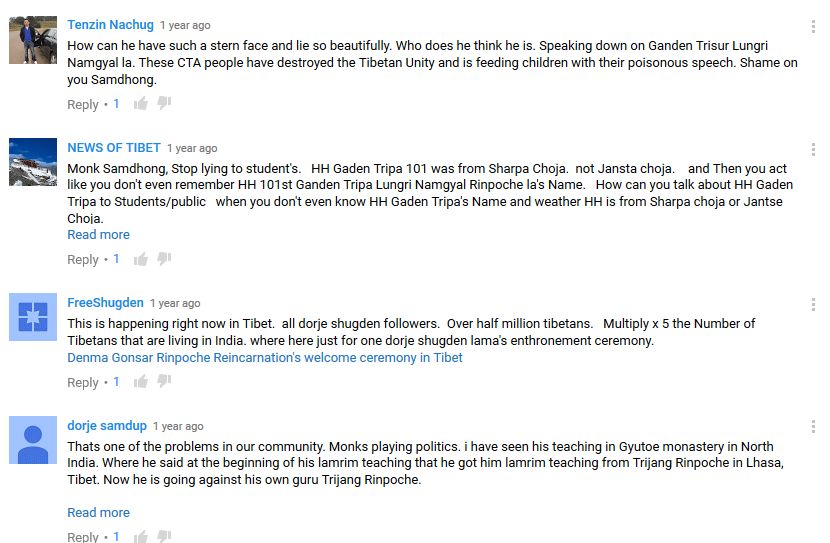
Click on image to enlarge
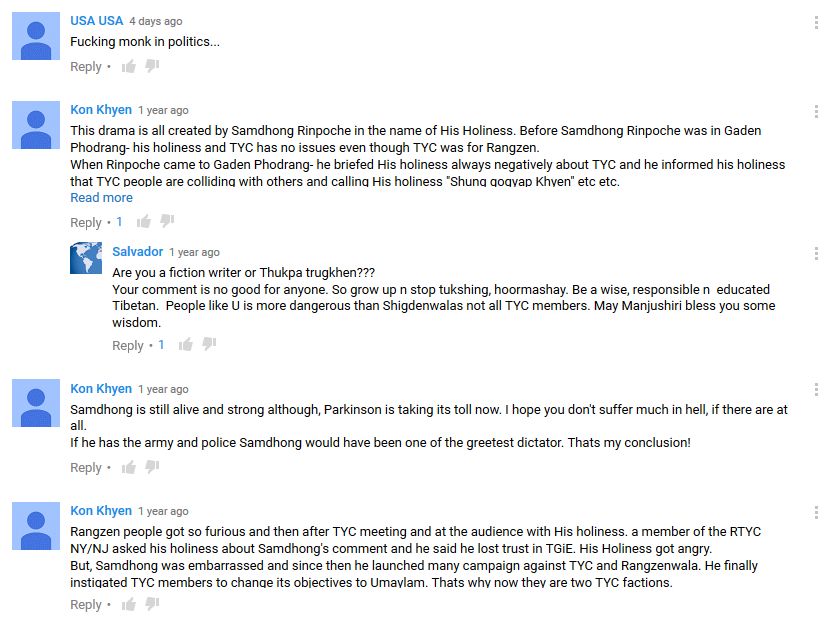
Click on image to enlarge
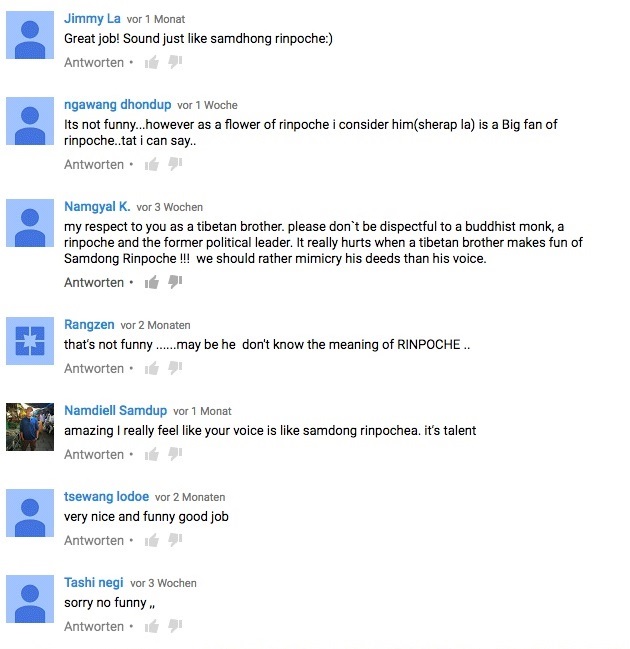
Click on image to enlarge
2. Congressman Rohrabacher’s Letter
Congressman Dana Rohrabacher of the United States in this letter is openly saying that the Tibetan government-in-exile (also known as the Central Tibetan Admnistration or CTA) has received so much financial aid from the American government. Yet the Tibetan leadership are not acting in a democratic manner. Why are the funds not being distributed for the welfare of the Tibetan people? How much more assistance should the United States direct towards such a profoundly corrupt and mismanaged regime, using taxes from the American people? Congressman Rohrabacher’s letter shows that even American sponsors are receiving reports of mismanagement of funds and corruption at the highest levels of the CTA. Unless the Tibetan people speak up against the corruption in their leadership, they may see a decline in global financial support for their cause.
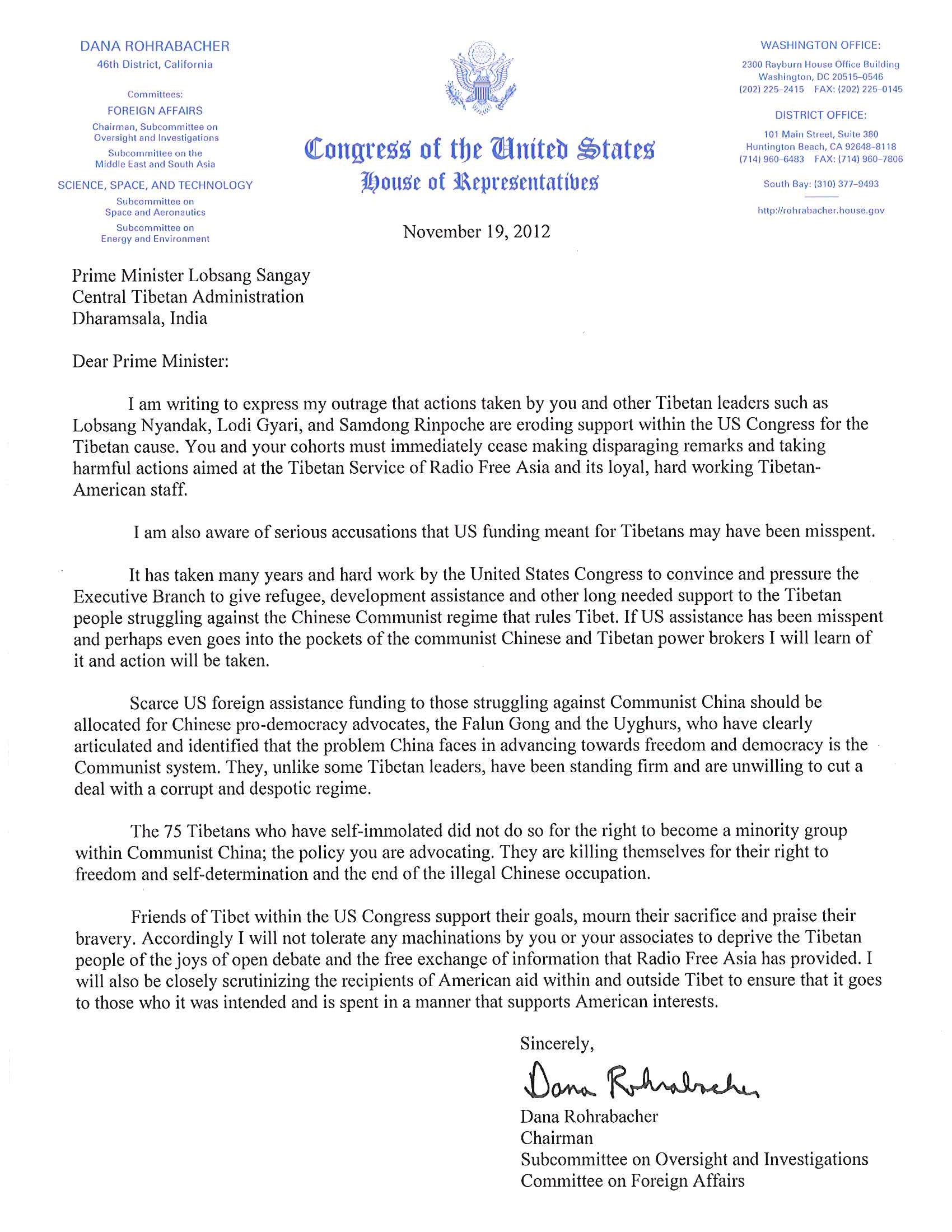
Click on image to enlarge
3. Lukar Jam Atsok’s Manifesto
Lukar Jam Atsok is very progressive, far-reaching in his thinking and very fair. That is why he will never be accepted and elected into the position of Sikyong, because he’s running on a platform of views that are different and diverge from the CTA’s and especially His Holiness the Dalai Lama’s views. Even his views of and proposed teatment of Dorje Shugden practitioners greatly differs from the Tibetan political establishment. In his electoral campaign, Lukar Jam had proposed a better, more comprehensive policy towards Shugden practitioners, having recognised that they all cannot be tarred with the same brush, and viewed as one homogenous group.
Having said that, the consensus in the Tibetan community is that he has made waves with his progressive and encompassing religious views. His manifesto and what he wishes to accomplish as a Tibetan leader is refreshing and unlike the current leadership, prioritises the welfare and future of the Tibetan people.
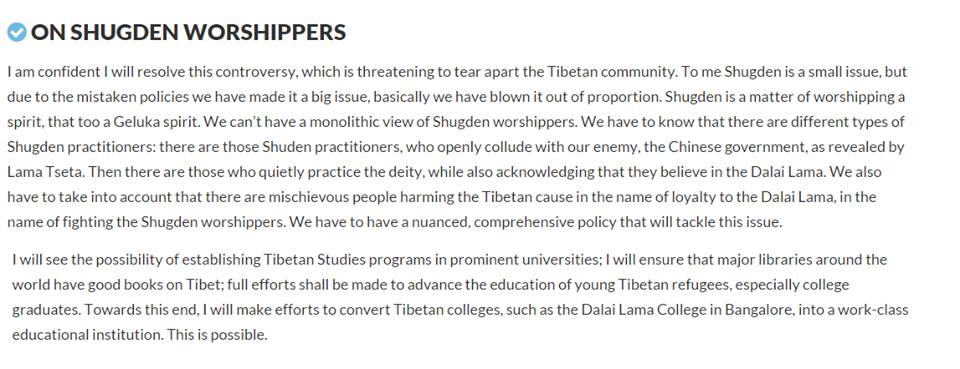
Click on image to enlarge
4. New York Times Article: Mudslinging Trumps the ‘Middle Way’ in Tibetan Exiles’ Election
For anyone to have a different opinion from the Dalai Lama, they will be considered extremely disrespectful and will usually even be labelled a traitor. Those in power in the CTA will condemn and even remove ‘disloyal’ individuals from participating in what is supposed to be a “democratic” election. Although politicians like Lukar Jam Atsok were ultimately unsuccessful in their campaigns because the CTA cannot run fair elections in a democratic manner, one good thing that has come from politicians like Lukar Jam running for Sikyong is that more Tibetans are beginning to speak up against the unfairness of their leaders. For example, Ms Dhardon Sharling and Ms Dicki Chhoyang have been powerful voices in speaking up against the current leadership and the way the elections have been conducted.
Below is the New York Times coverage of the electoral campaigns. Please take note that the New York Times is a reputable media outlet, and not tabloid or sensationalist in nature. Their coverage of the electoral campaigns asks some hard questions of the Tibetan leadership, and highlights the petty way in which the elections were coming up. Is such pettiness the mark of a mature democracy? Certainly not.

Click on image to enlarge
5. An Open Letter to the Sikyong
This is an open letter to the Sikyong Lobsang Sangay, Kashag (the Tibetan Parliament), and Election Commissioner of the Central Tibetan Administration (CTA) in Dharamsala, India by 27 long-time Tibet supporters living all over the world. These powerful individuals state very strongly and clearly how they recognise and object to the CTA’s undemocratic practices that are many and serious.
They point out that the electoral rules constrain the Tibetan people’s right to free speech, and that the leadership’s behaviour is inconsistent with their own claims of being a democracy. The ruling by the Election Commission after the preliminary ballots was a breach of the Tibetan community’s human rights. The Tibetan leaderhip’s behaviour throughout the Sikyong elections shows clearly their double standards and behind-the-scenes manipulations to achieve their goals – that is, to maintain the status quo in the government by preventing new, different voices from participating in the political process. They indicate that if the Tibetan leadership is not held accountable to anyone and it continues to behave in this way, they are in danger of losing their own people’s trust. There is even a danger of the Tibetan leadership acting AGAINST their people’s best interests. Thus more and more people are beginning to see the corruption and lies behind the CTA.
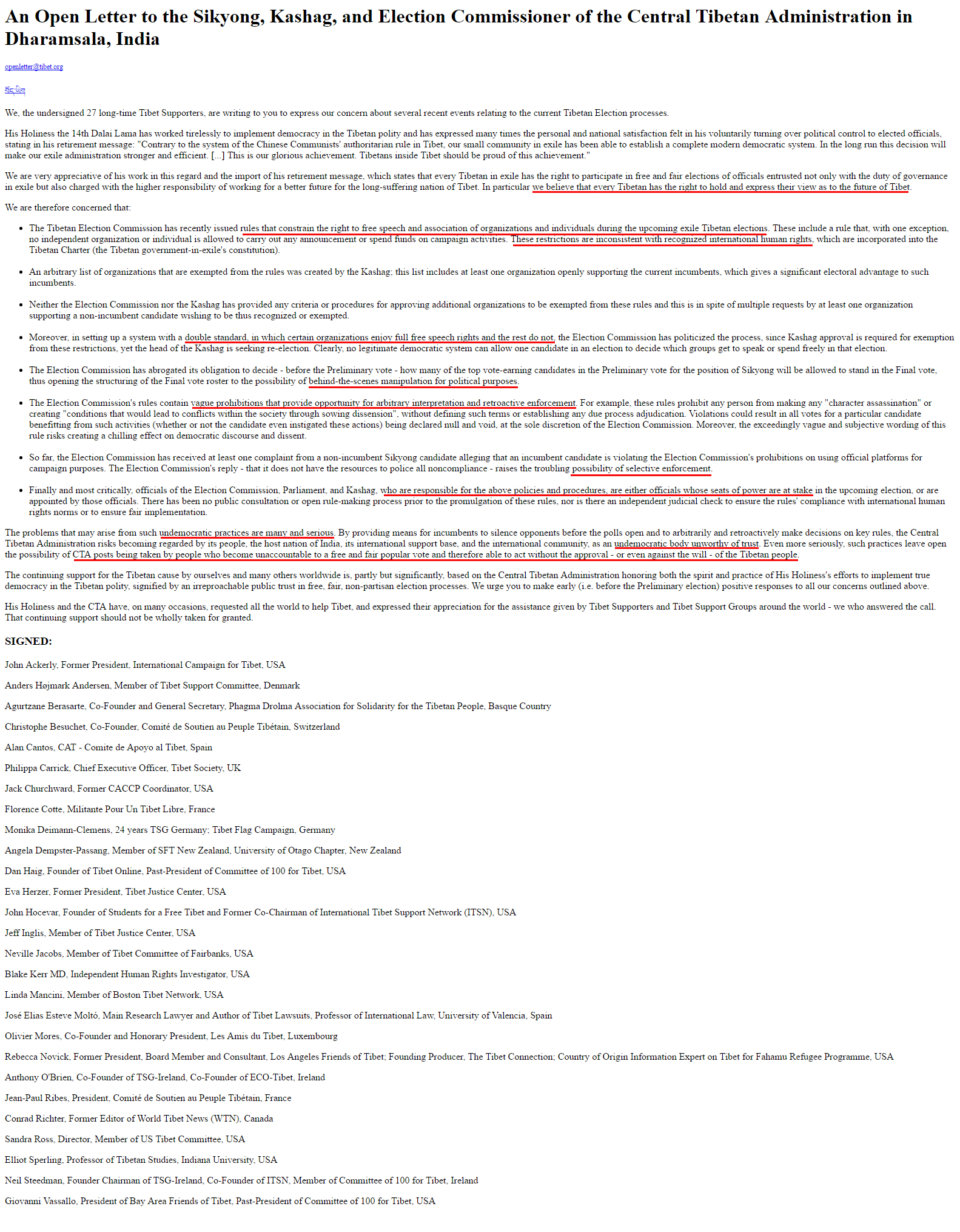
Click on image to enlarge
6. Tibetan Youths Question Sikyong Lobsang Sangay on Dorje Shugden
During a question and answer with the Sikyong Lobsang Sangay, Tibetan youths spoke up against the ban on Dorje Shugden. Several students pointed out how much the Dorje Shugden issue has divided the Tibetan people and exposed the lies of the Central Tibetan Administration. One student for instance asks the Prime Minister directly about the nature of the accusations expressed during the protests against the ban on Dorje Shugden.
As you can see, Lobsang Sangay purposely avoided some questions. His displeasure at being questioned was obvious; his mood and face visibly darkened when the students questioned him. If he was so confident about the ban on Dorje Shugden, and there is a logical basis for the ban, he would have been able to answer their questions confidently instead of showing displeasure to young Tibetans who dare to think and speak up.
It has been reported that after the session, the youths were called away for questioning and their loyalties to the Tibetan leadership were put under scrutiny. What kind of leader treats the youths of his nation in this way? How does it nurture leadership skills and abilities in the Tibetan community, and encourage Tibetan youths to engage in the political process when their very own leader bullies and intimates them into silence?
Below are some of the comments that accompany the video on YouTube. The Prime Minister’s reaction towards the student was noticed by many.

Click on image to enlarge
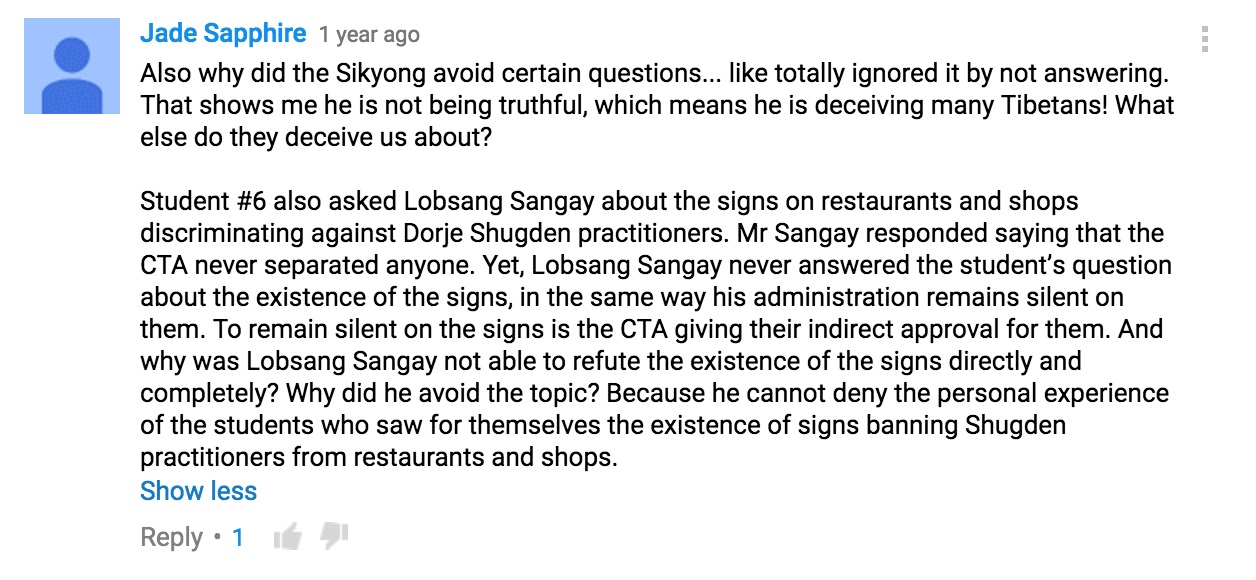
Click on image to enlarge

Click on image to enlarge
7. Kalon Dicki Chhoyang’s Resignation
In March 2016, Minister for the Department of Information and International Relations for the Central Tibetan Administration, Dicki Chhoyang, abruptly resigned from her post after serving for four and half years and quitting a few months before her term ended. She initially stated that she was resigning because of collective interest and the significant challenges that lie ahead for Tibet, but she later gave further insights into her resignation in a later statement. These included mentions that the range of issues debated during the Sikyong election has been disappointing with their irrelevance to the current situation in Tibet and the political movement.
Ms Chhoyang also highlighted some personal character traits which she considered important for a Sikyong candidate. According to Tibet Sun, her statement is a clear criticism of Sikyong Lobsang Sangay, and elaborates on why he is not the right person to be elected to the post of Sikyong. Before her official statement, many Tibetans were restless over the incident and resorted to social media requesting Ms Chhoyang to open up about her resignation before the final election. They left comments speculating over serious problems in the Parliament, as well as the poor leadership of Lobsang Sangay that caused her resignation.
Isn’t it interesting that a minister of the current sitting Parliament would feel it is necessary for her to resign from her position in order to speak freely? What has been happening behind the scenes in the Tibetan Parliament where current sitting ministers cannot speak their minds freely? Is it because they are expected to ‘tow the party line’ if they are sitting Ministers and dissent or divergent views are not allowed?
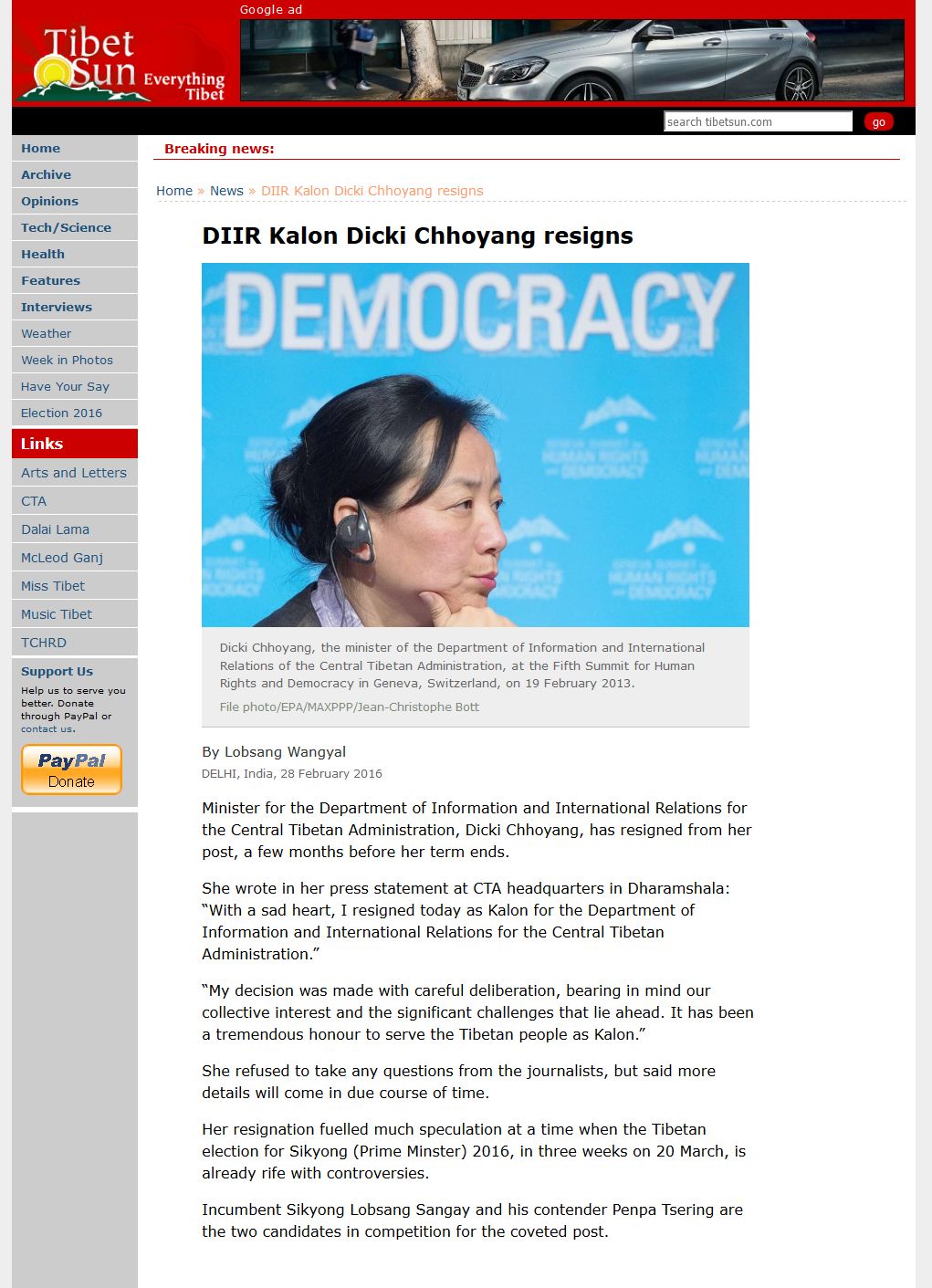
Click on image to enlarge
Above is the video recorded by Ms Dicki Chhoyang relating to her reasons for resigning from the Tibetan Government in Exile and below are just a sample of the comments to the video. Her resignation has generated a lot of interest and conversation in the Tibetan community.
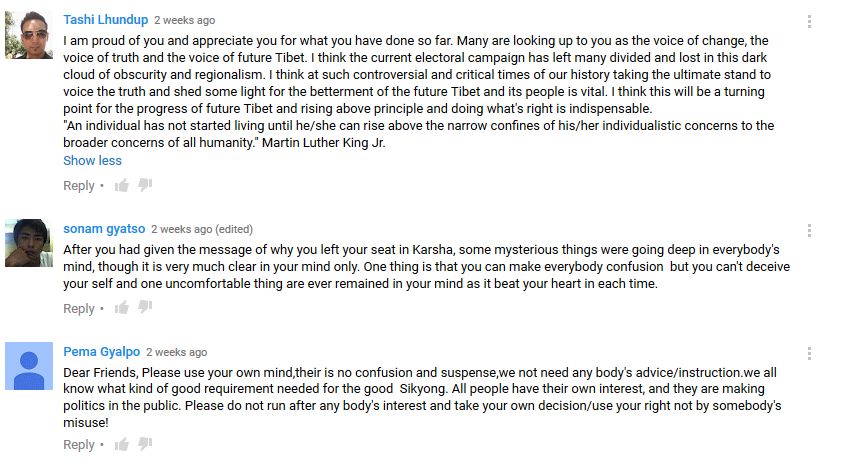
Click on image to enlarge
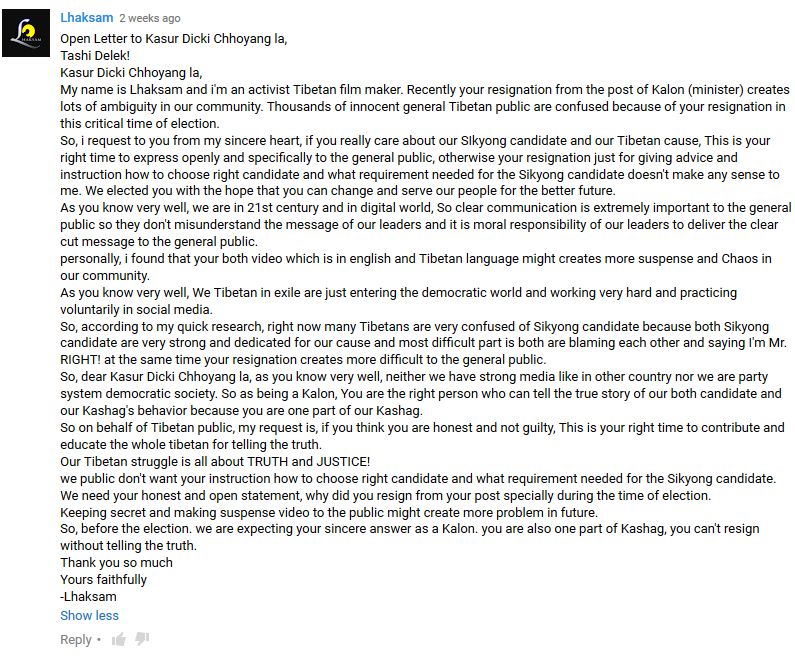
Click on image to enlarge
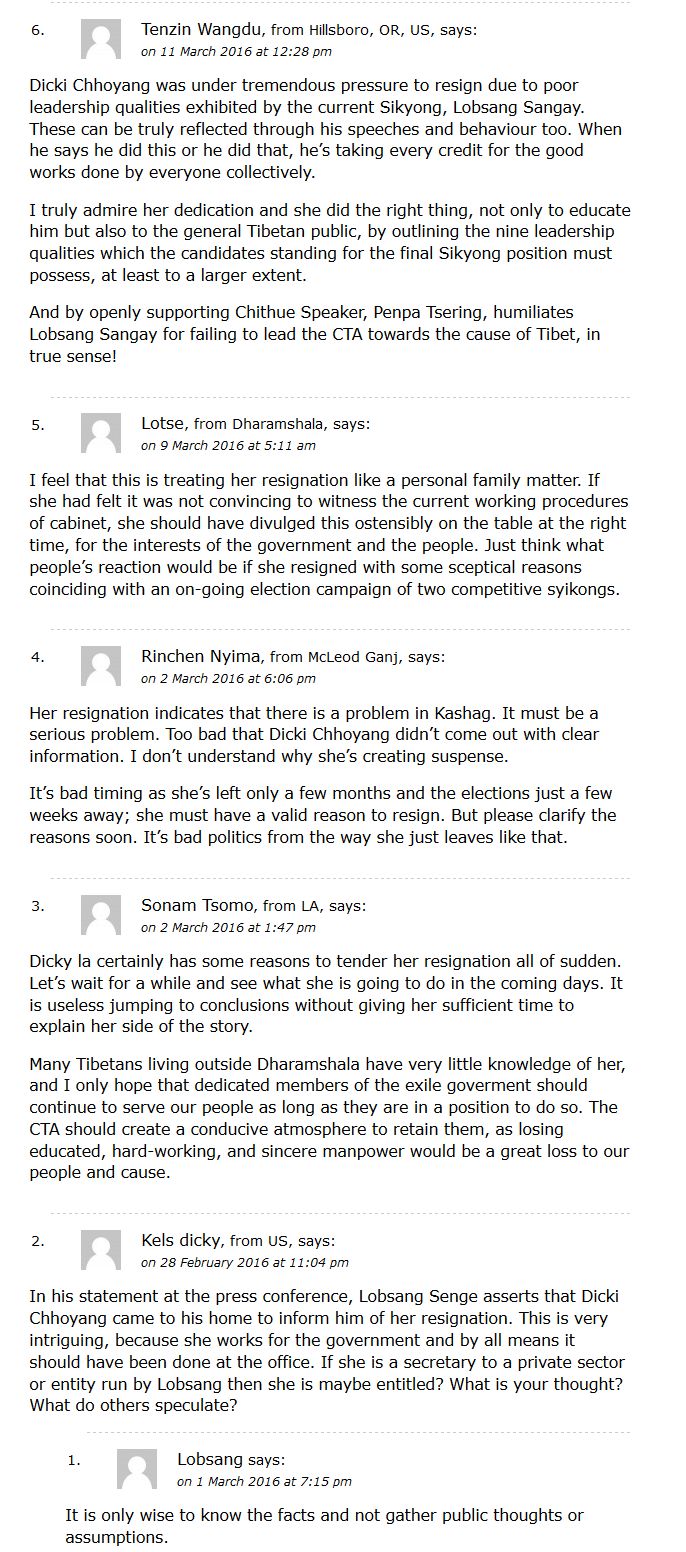
Click on image to enlarge

Click on image to enlarge
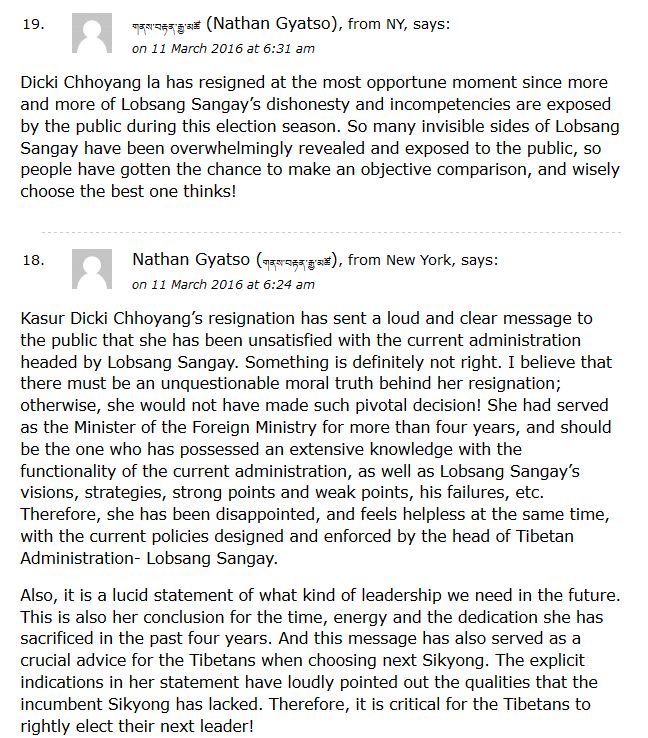
Click on image to enlarge
8. Monks in the 15th Tibetan Parliament Criticize the Shugden Ban
In March 2015, during a session of the 15th Tibetan Parliament, a parliamentarian who is also a monk commented that the Parliament should discuss problems and solutions, especially those which are happening “right under the Dalai Lama’s nose”, for example the misuse of government property, corruption and murders by certain member of the Tibetan Parliament.
He also pointed out that the Parliament have not fulfilled many things the Dalai Lama has said and wished for, and that the Dalai Lama’s name has been used for personal gain. One of the examples he brought up was the ban on Dorje Shugden, which the current Dalai Lama told everybody that he did not start the ban and that it came from the 5th Dalai Lama. People who are familiar with Tibetan culture will understand that the parliamentarian was implying that many problems have arisen in the Tibetan communities as a result of “the Dalai Lama’s wishes”. This is a clear example that even a parliamentarian is now speaking up about the failure of the Tibetan Parliament in Exile (TPiE), the unicameral and highest legislative organ of the Central Tibetan Administration (CTA).
Something must be happening in the Parliament where parliamentarians are now doing what was previously unthinkable – holding His Holiness the Dalai Lama responsible for the problems faced by Tibetan society. What is lacking in the leadership that those involved are now so frustrated, that they will even call into question the logic of following His Holiness’ instructions?
9. Penpa Tsering Resigns
Penpa Tsering has been a strong advocate of the Dorje Shugden ban and his stance has never changed. In 2015, during a parliamentary session, Penpa Tsering walked out abruptly after he was accused of murder and he was unable to refute the charges. Instead of standing his ground and insisting his innocence, he stormed out of the meeting like a petulant diva, leaving everyone stunned that a grown man would act in this manner. No one even attempted to hold him back.
The real issue is, why does someone have to be afraid over things that they did not do? If you did not do it, stand your ground and say you did not do it. Why do you have to QUIT to prove you are innocent? What kind of Tibetan leader behaves in such an immature manner, like a child who has just been admonished and is now sulking over their treatment?
10. The Leadership are Silent on Self-Immolations
The first self-immolation in Tibetan society in the modern era took place in Delhi, India on April 27, 1998, when Thupten Ngodrup set himself on fire and later passed away.
Those who self-immolate are desperate. They are desperate and frustrated, and have to express themselves in such an extreme way because they think that it is the only way to grab the attention of the media. However, instead of working to show his people that the leadership are capable of achieving their goals without the people having to resort to such extreme measures, the ex-Prime Minister Samdhong Rinpoche was quoted as saying, “We should support all those that have sacrificed their life for the Tibetan cause.”
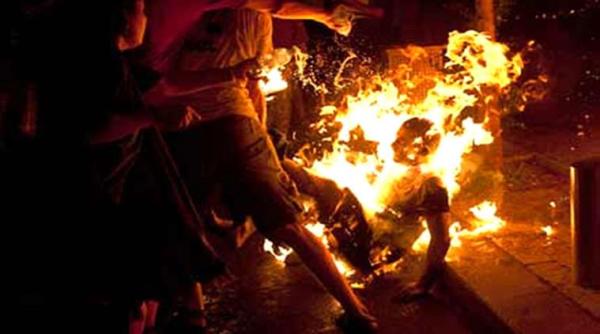
Scores of young Tibetans have killed themselves and yet their leadership remains silent and ineffective
What kind of leadership supports the death of their people? What kind of leadership calls for their people to behave in this manner, and even encourages them to commit suicide? Every life is precious and no one should be killing themselves. If being alive does not solve the issue, how is being dead going to help? In fact, His Holiness the Dalai Lama has remained relatively silent over the issue of self-immolations; instead of asking his people to stop (which they would), His Holiness has said very little about resolving the issue.
While the Tibetan leadership remain silent over the increasing death toll, they continue to promote and incite harm against Dorje Shugden practitioners, creating a huge division within the Tibetan community. Why does the leadership direct resources towards persecuting people’s religion, instead of directing resources towards the resolution of the Tibetan issue so that no more Tibetan youths have to sacrifice their lives?
Below is the list of all Tibetans who have self-immolated in the name of the Tibetan cause (whatever that may be). The Tibetan leadership have done little to stop this list from growing and in some cases, have even encouraged the self-immolations. Without a drastic change in their attitude towards the continuing suicide of their people, and without efforts to pacify their people’s frustrations over the lack of political progress, it is inevitable that this list will only grow longer.
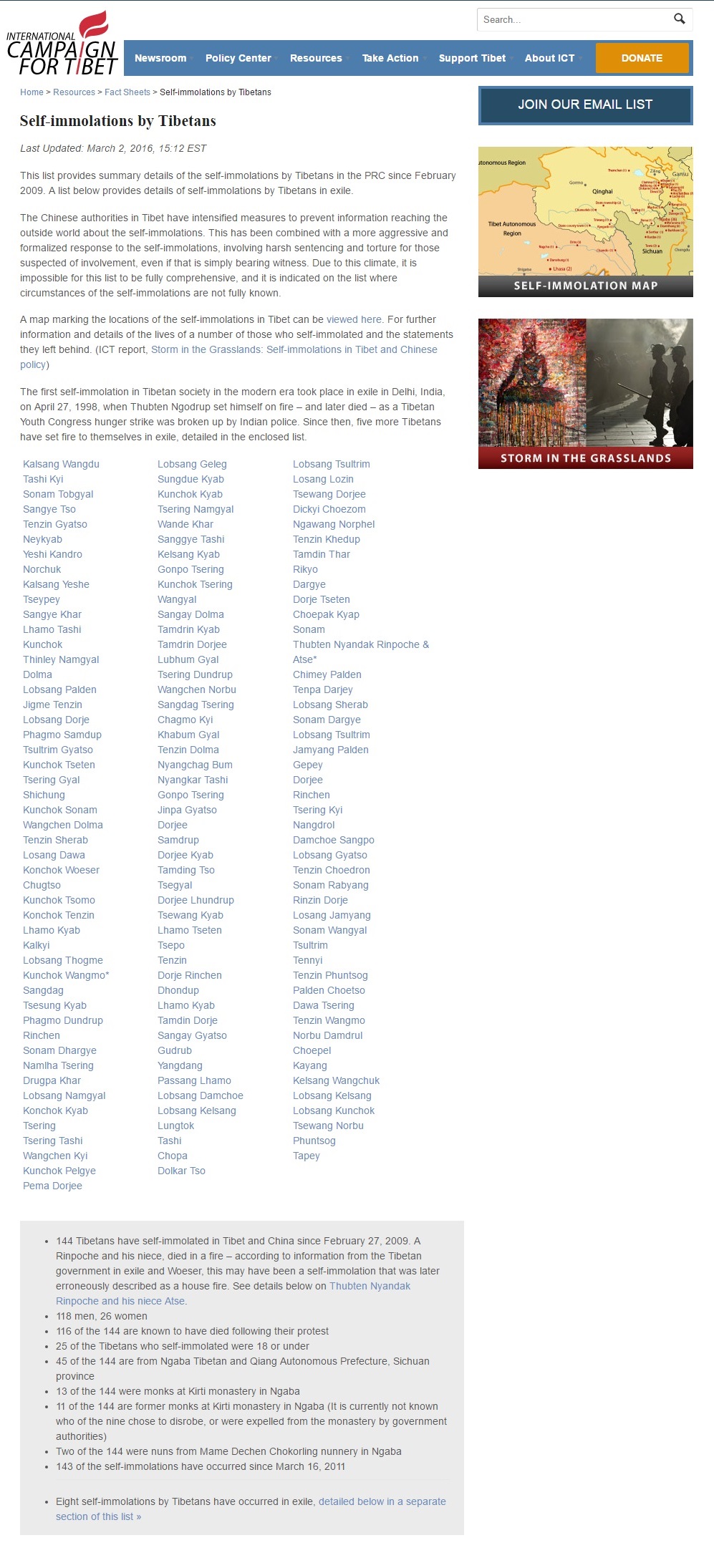
Click on image to enlarge
11. Nyingtam Rap Song
This rap below titled ‘Nyingtam’ was produced to highlight how the Dorje Shugden ban has affected millions of peoples’ lives, splitting families, friends and monasteries apart. Dorje Shugden practitioners, even those who live in exile, are heavily discriminated against and they do not even have the slightest religious freedom and rights to follow their own faith.
The song therefore is a way for Tibetans in exile to express their frustrations with the problems created by the Tibetan leadership which has affected Tibetan lives for the last 60 years. The Dorje Shugden ban has been going on for too long and it is the time now to resolve the issue and bring all Tibetans together so that they can live in peace and unity.
English translation
Shame!
It’s a real shame!
All of you are the ones engaged in shameful acts
It is all of you who are causing the innocent to suffer
All of you are the ones engaged in lies, deception and slander
Tibetans
Listen up carefully
It would have been really difficult without Trijang Rinpoche and Shugden’s involvement
For the Dalai Lama to arrive safely in India from Tibet
Just leave aside Dalai Lama, his name would not even exist today without them
How did the Dalai Lama get all the knowledge he endows?
It was Trijang Rinpoche who offered him the Ocean of knowledge and the world knows it
I clearly remember eating steamed buns at the TCV School (Tibetan Children’s Village)
Stop thinking immaturely and stop talking nonsense
It was Trijang Rinpoche who founded the TCV School
Even the national anthem you chant is composed by our Lama (Trijang Rinpoche)
Ungrateful people, all of you should be ashamed
Look at your work
Two Karmapas
Two Panchen Lamas
Issues arising from viciously mixing religion and politics
The Chushi Gangdruk(Tibetan guerrilla fighters) issue
The Dorje Shugden issue
If I were to really start talking about the issues, it would impossible to cover all of them
Donkey Penpa Tsering, don’t belittle and make careless remarks.
The vicious mixing of religion and politics is not what you should teach the students
Don’t slander and belittle the lineage holders of the Gelugpas
You who are engaged in murderous and bloody acts, you will be going to hell for sure.
You don’t even show the slightest result of Dharma learning
But you sure have a BIG MOUTH!!!
It’s the Dalai Lama who separated the Tibetan people
It’s the Dalai Lama who divided the monasteries
It’s the Dalai Lama who divided families
It’s the Dalai Lama who split friends apart
Before 1996, we friends and relatives lived together harmoniously
After 1996, we got completely divided
This unnecessary issue
Is created by the Dalai Lama
It disrupted all six million Tibetans
Just like you stir a pot of noodles (thukpa)
All the unity was destroyed
Forget about consensus and unanimous resolutions
It really saddens me
And I shed tears of blood
But what can we do?
Until our flesh is worn down to the bone, we will fight for truth and justice
Us vajra brothers and sisters
The only thing we think about is Dharma
Kyabje Trijang Chocktrul
Is our supreme guide
And we proudly state that
All of you are the ones engaged in shameful acts
It is all of you who are causing the innocent to suffer
All of you are the ones engaged in lies, deception and slander
It’s the Dalai Lama who separated the Tibetan people
It’s the Dalai Lama who divided the monasteries
It’s the Dalai Lama who divided families
It’s the Dalai Lama who split friends apart
12. The Jonangpas Protest
The Jonang sect, a school that has been suppressed since the time of the 5th Dalai Lama is also speaking up now. The Jonang sect is a Buddhist school which can trace its origins back to the 12th century. After being suppressed and persecuted for 400 years, His Holiness the 14th Dalai Lama finally recognised the Jonang as a major sect of Buddhism in September 2011.
But five years after they were recognised as a legitimate school of Buddhism, the Jonangpas still have no representative in the Tibetan Parliament. The Jonang monks were protesting outside the Tibetan Parliament, requesting to be treated equally like the other Buddhist sects, all of whom have representatives in the Tibetan Parliament-in-Exile. Protests by the Jonangpas against the unfair and undemocratic methods of the CTA have even escalated into violence.
In September 2015, monks and nuns protested in front of the Tibetan Parlament for equal representation. The monks protested by hunger strike and a fight was even recorded on camera. It seems that more and more groups of people are becoming increasingly frustrated with the unfair treatment of the Tibetan Parliament against their communities.
13. Phayul Comments
The content on Phayul.com, a popular website that publishes news and opinions about Tibet and Tibetans in exile, reflects how Tibetans are speaking up and expressing their frustrations about the failure of the CTA, especially in relations to the recent Sikyong election. Their frustrations range from Lukar Jam being unfairly removed from participating in the final election, as well as criticism of the Sikyong candidates and the electoral process.
Some Tibetans have boycotted the election and refused to vote, one of which includes the former Sikyong candidate Lukar Jam himself. The first directly elected Prime Minister of the Tibetan Government-in-Exile, Samdhong Rinpoche himself has also refused to vote.
The 2016 Sikyong elections have been a total shambles, with accusations of corruption and manipulation of the voting process by the very body responsible for overseeing the elections. There have been parliamentarians resigning so they can speak freely, and candidates and former Prime Ministers refusing to vote. Why is the Tibetan leadership which has just 88,000 voting constituents, so incapable of running an election that is free from scandal and corruption?
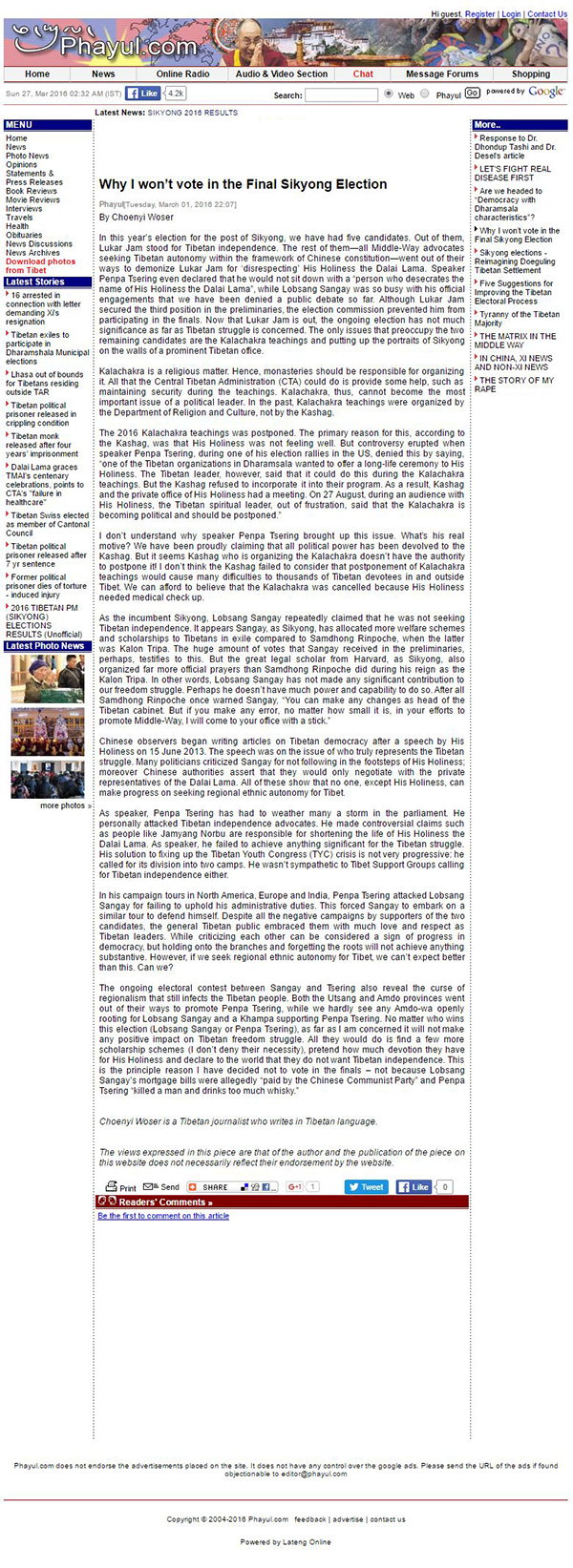
Click on image to enlarge

Click on image to enlarge
14. Andrew Korybko
Andrew Korybko is a political analyst, journalist and a regular contributor to several online journals, as well as a member of the expert council for the Institute of Strategic Studies and Predictions at the People’s Friendship University of Russia. He specializes in Russian affairs and geopolitics, specifically the US strategy in Eurasia. His other areas of focus include tactics of regime change, colour revolutions and unconventional warfare used across the world.
In this video you will hear that Andrew Korybko giving a very incisive commentary on the biased report by Reuters titled “China co-opts a Buddhist sect in global effort to smear Dalai Lama”, published on Dec 21, 2015.
Andrew Korybko talks about Reuters’ anti-China fail. In the report, they tried implicating Beijing for supporting the supposedly anti-Dalai Lama Buddhist group, the ISC (International Shugden Community). In reality however, they actually raised awareness about the autocratic sectarianism of the Tibetan leadership. Andrew pointed out that the entire Reuters report is misinformation and that Reuters will write whatever suits their agenda – that is, anything pro-Dalai Lama is good and anything that opposes the Dalai Lama is bad, even if it is other Buddhists and even if they are Tibetans. This is exactly what is happening to Shugden practitioners and the Tibetan people at large.
He points out how the article is condescending to the reader. It shows how desperate Reuters and their sources are, feeding them stories to manufacture any kind of anti-Chinese, pro-Dalai Lama message no matter the consequences for those involved. Any good journalist who is impartial and makes the effort to investigate will easily sniff out the sectarianism within the Tibetan leadership, where those in power will control the Tibetans and use their loyalty to the Dalai Lama against them, just so they can stay in power. Few Tibetans have the resources and capability to conduct such investigations, having been raised to have full and unwavering trust in their leadership. This is why the Tibetan Leadership has been able to get away with exploiting their people for over 60 years. However, no matter how they try to hide and twist the truth, the truth will prevail. Now it looks like more and more people are identifying the cracks behind the lies and speaking out against it.
15. Tibetan Youths’ Blogs
As technology results in more people being exposed to newer and different information and ways of thinking, we are seeing more people speaking up against anything that is unjust and in this case, it is the Tibetan leadership.
The Central Tibetan Administration (CTA) is well-known for their corruption, double standards and hypocrisy. The older generation of Tibetans have been living under the extreme suppression of their leadership and they did not dare to speak up because there would be repercussions. Plus, being a newly exiled community meant they did not have many options in terms of alternative forms of employment, alternative places of education, as well as migration and travel. If they were persecuted as being against the leadership, life would become extremely difficult for them.
Fortunately, thanks to the advancement of the internet and technology, Tibetan youths today are more outspoken and educated, and they are not afraid to speak up against the “opponents”. This is a very good sign and trend because Tibetans have been suffering for the longest time. Now they have the knowledge, resources and exposure necessary to protect their human rights and individual freedoms.
Below is just a sample of intelligent, incisive Tibetan blogs providing an analysis into the behaviour of their leadership. Such publications would not have been tolerated by the establishment just ten years ago but today, the people’s frustrations with their leadership have pushed them to speak up. And more and more people will continue to speak up in this manner, and such articles will become more commonplace if the Tibetan leadership do not change their method of governance.
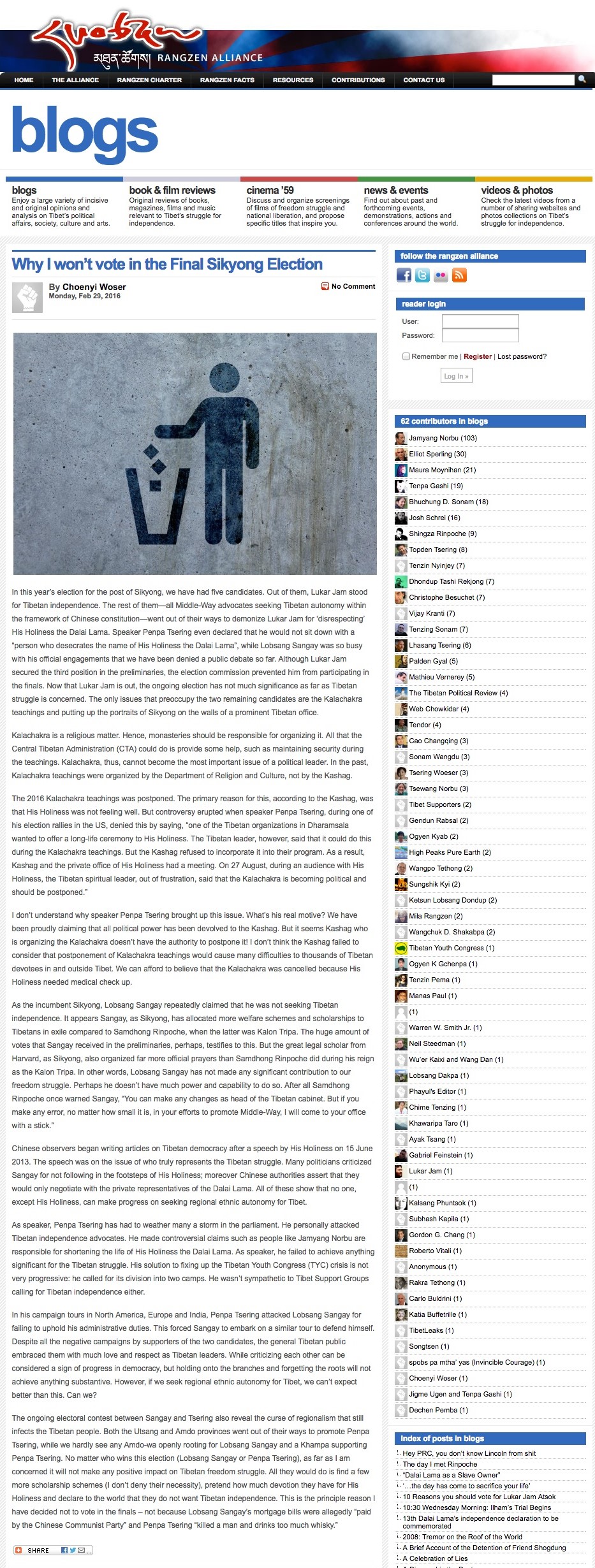
Click on image to enlarge
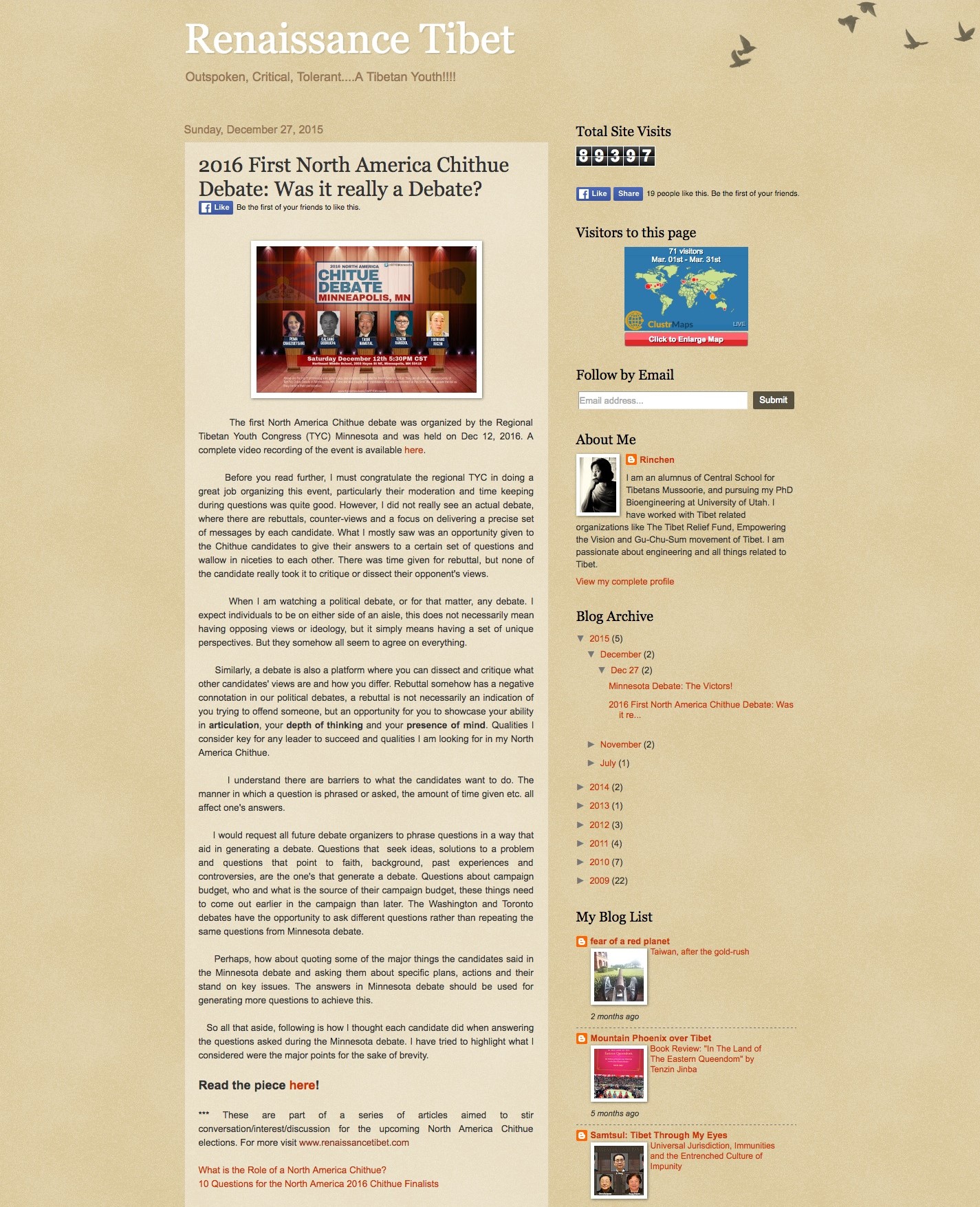
Click on image to enlarge
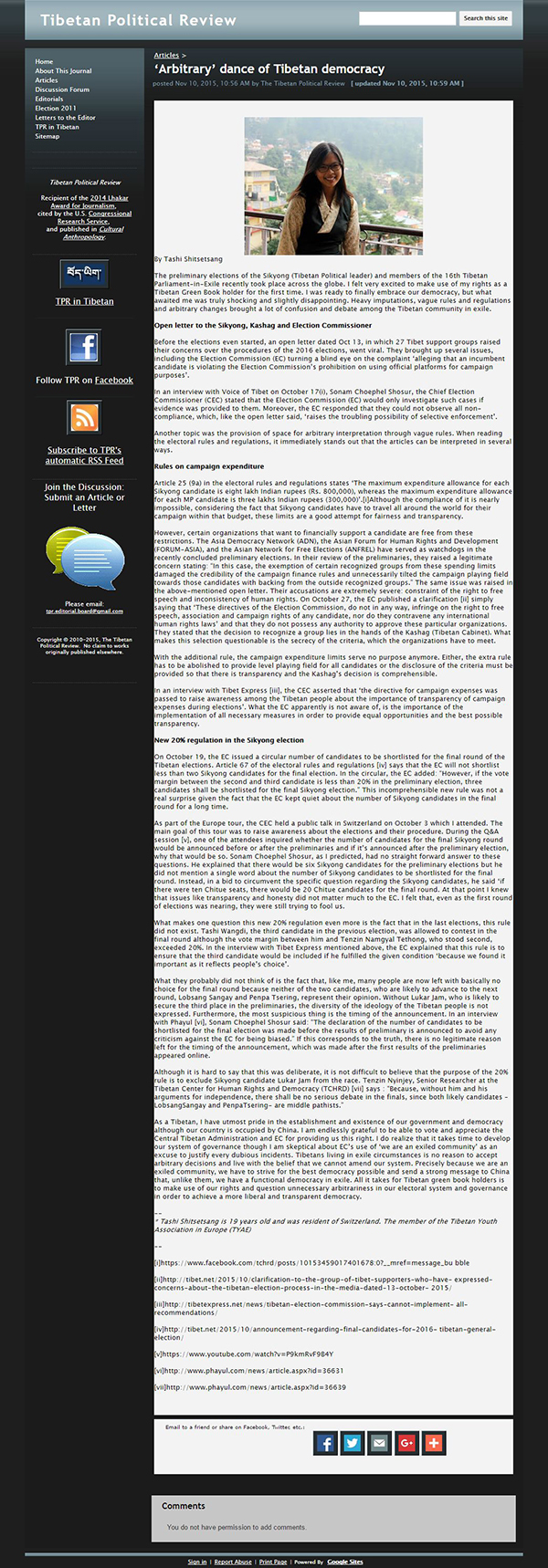
Click on image to enlarge
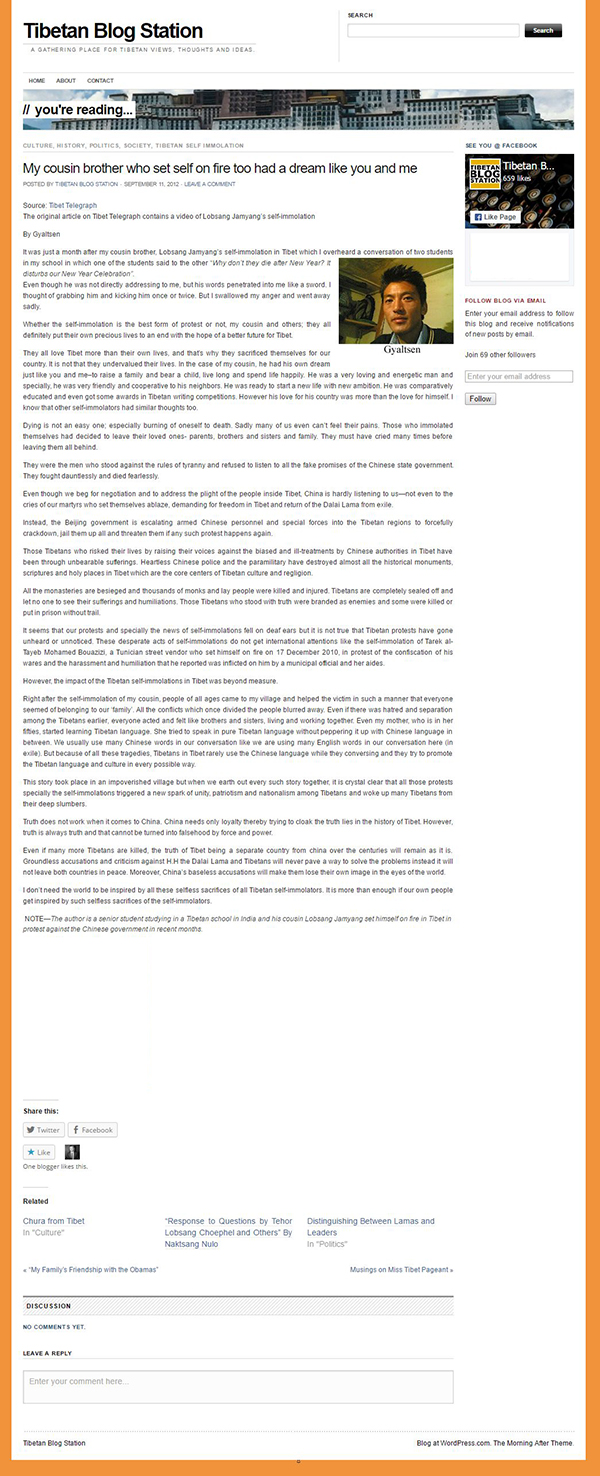
Click on image to enlarge

Click on image to enlarge
Source: http://www.sikyong2016.com/paradox-of-10-accomplishments-of-sikyong-lobsang-sangay
16. RTYC NY / NJ Issue
There are two views or approaches regarding the Tibetans wish to return to their homeland. The first view is the full independence view (or rangzen), which His Holiness the Dalai Lama used to promote. The view espouses that Tibet should be its own fully independent nation. The second view is the Middle Way Approach (or umaylam), which His Holiness the Dalai Lama now supports and promotes as the right approach. The view espouses that Tibet should have meaningful autonomy.
In the last two years, there have been increasing clashes between those who support the rangzen view and those who prefer umaylam. In March 2015 in New York, Tibetans protesting for their cause erupted into a fight. The New York Police Department had to step in and intervene before it escalated into further violence. Since that time, relations between the two groups have been uneasy. The umaylam people have accused the rangzen group of being anti-Dalai Lama because they do not support His Holiness’ preferred choice of umaylam.
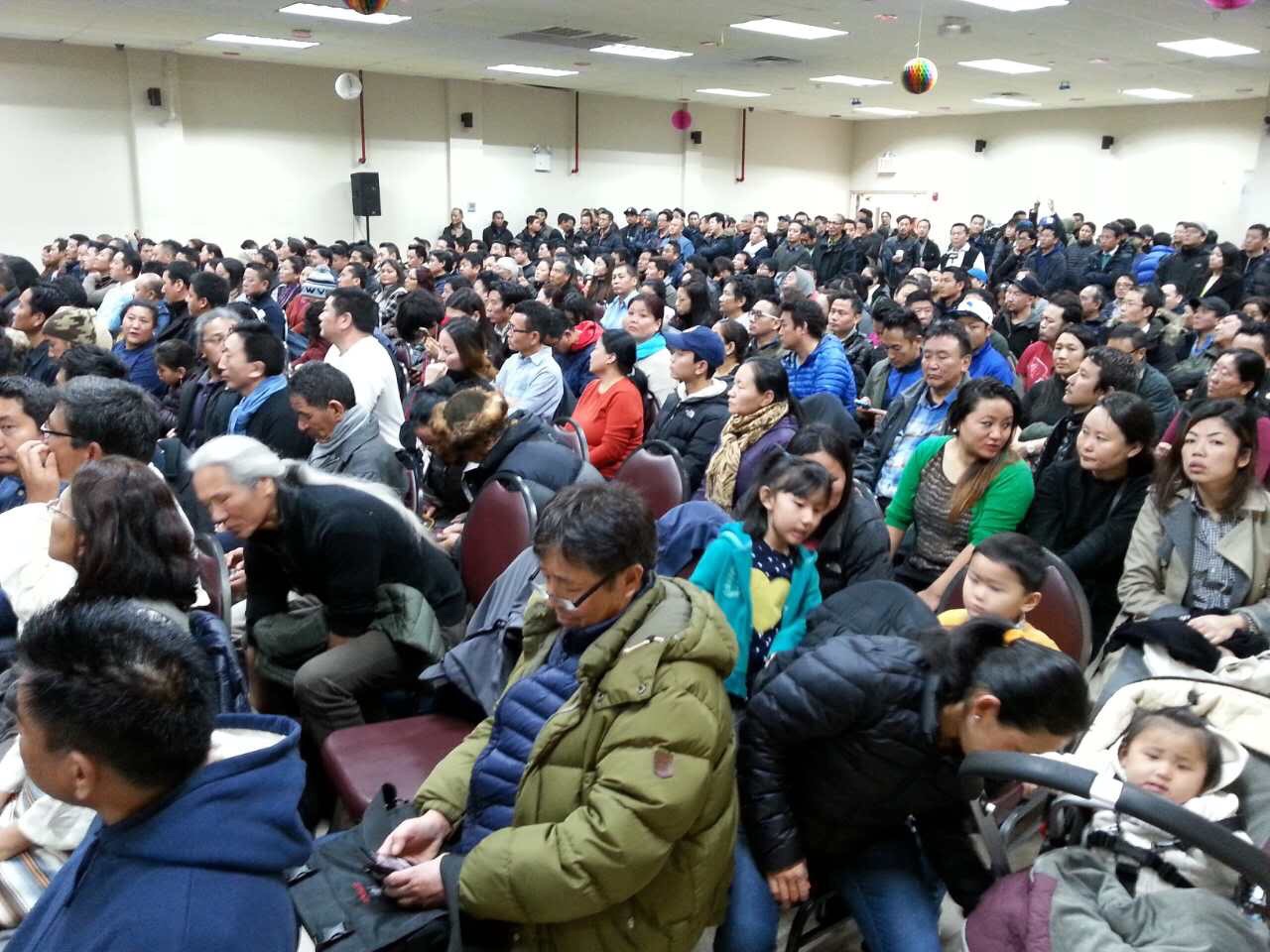
1000 people attended the meeting in support of the rangzen view
In early 2016, the umaylam group (who support His Holiness the Dalai Lama) had a meeting which 300 people attended. Since they support the Dalai Lama’s approach, they have a very good relationship with Kukey Yiktsang (the Private Office of His Holiness the Dalai Lama). Later, the rangzen group (who are against His Holiness the Dalai Lama’s umaylam) also had a meeting. A total of 1000 people showed up, and the President of the Tibetan Youth Congress (TYC) from their Dharamsala headquarters flew in to speak with them.
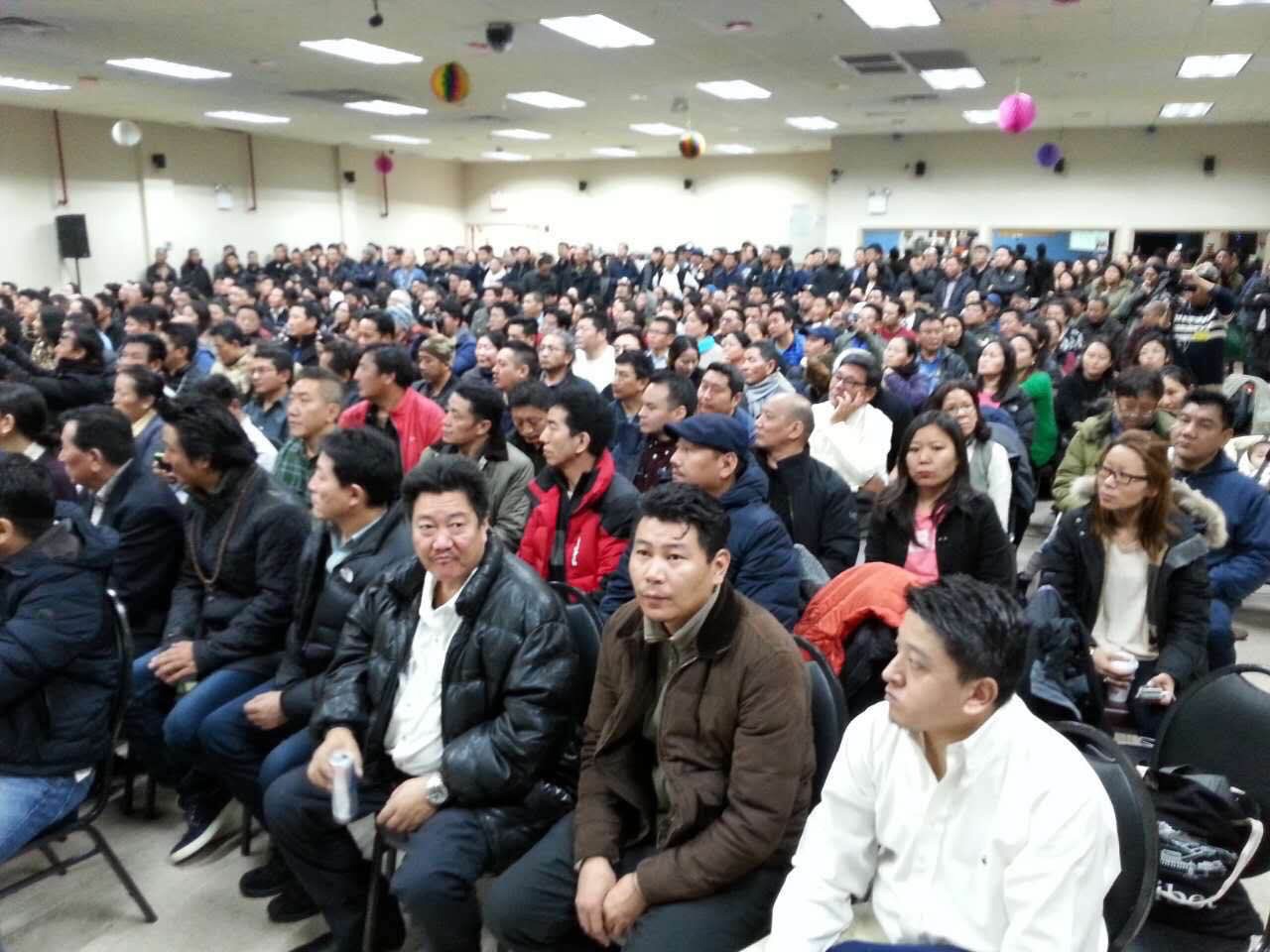
Click on image to enlarge
In the video below, there is a man speaking during the rangzen meeting. The man in the video is saying that they are all Tibetans and just because they fight for rangzen, the umaylam people despise them and tried to sabotage their meetings. No matter what it is, people who support rangzen are also Tibetans. The man requests His Holiness the Dalai Lama to inform supporters of umaylam that supporters of rangzen are not malicious, and asks them not to create division and problems.
First of all, the disparity in numbers between the umaylam and rangzen groups show that there is overwhelming support for the rangzen view. In the past, it would have been unthinkable for only 300 people support the Dalai Lama’s view, while 1000 people support a different view. Furthermore, the testimony of the man in the video shows that people who do not support the Dalai Lama’s view are not allowed to host their activities freely. Why prevent rangzen people from meeting and speaking, when they have freedom of speech? Why despise rangzen people, just because their views do not agree with His Holiness’? Are people not allowed to disagree with His Holiness the Dalai Lama? Does everyone have to agree with His Holiness the Dalai Lama? Is this how the Tibetan leadership encourages democracy?
17. Screenshots of Tibetans’ comments
Below are some screenshots of comments from various websites of Tibetans speaking up and even questioning the leadership of the Central Tibetan Government (CTA).
This is a very significant trend as it shows that Tibetans now are more exposed and educated. They are not afraid to speak up and they will not tolerate the Tibetan leadership’s political manipulation. They should not be afraid to stand up for their rights because no one has the authority to sabotage their religious freedom. We are now living in the modern era, where everyone is moving forward and working towards a more harmonious future. This kind of archiac, medieval and petty administration should stop now or Tibetans will never unite as one.
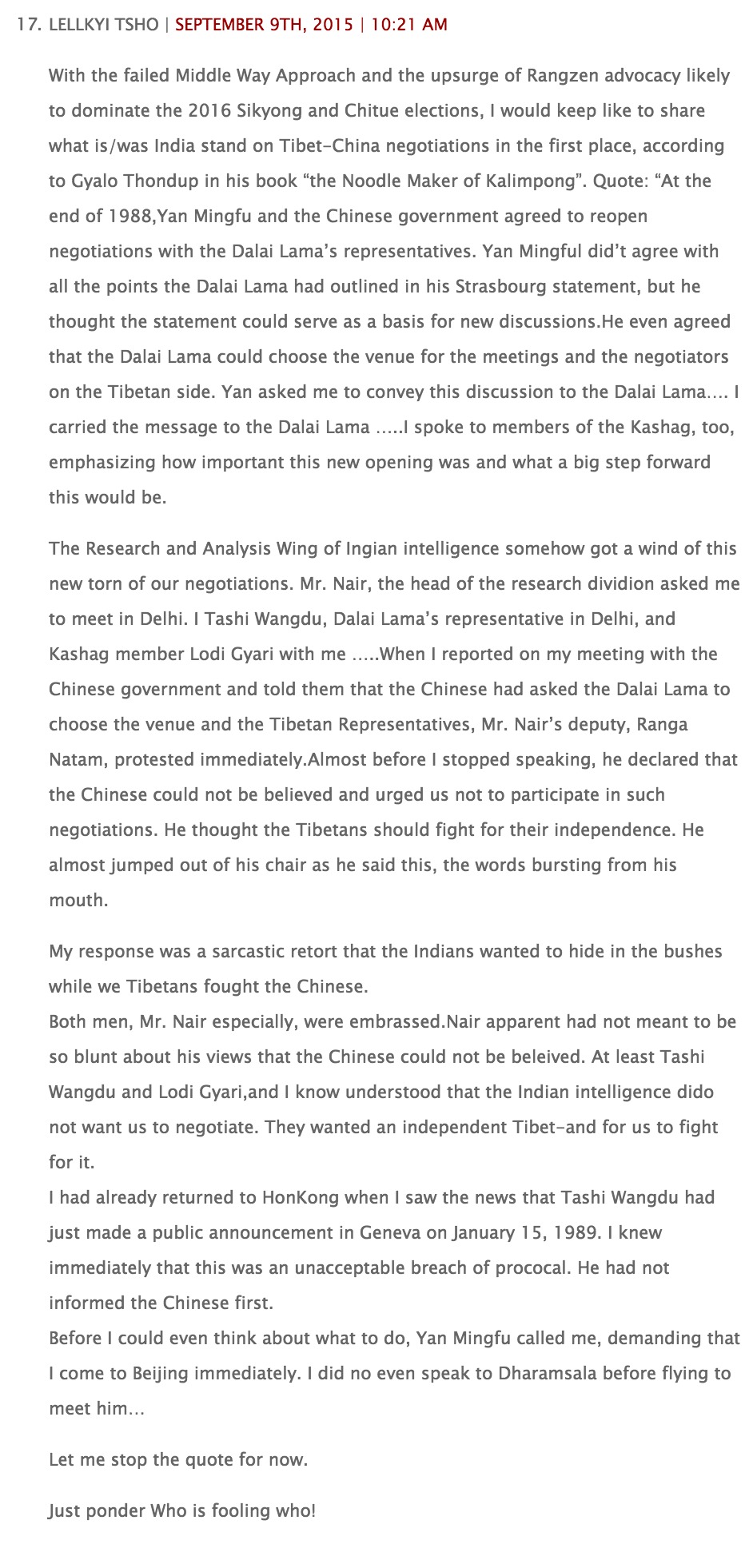
Click on image to enlarge
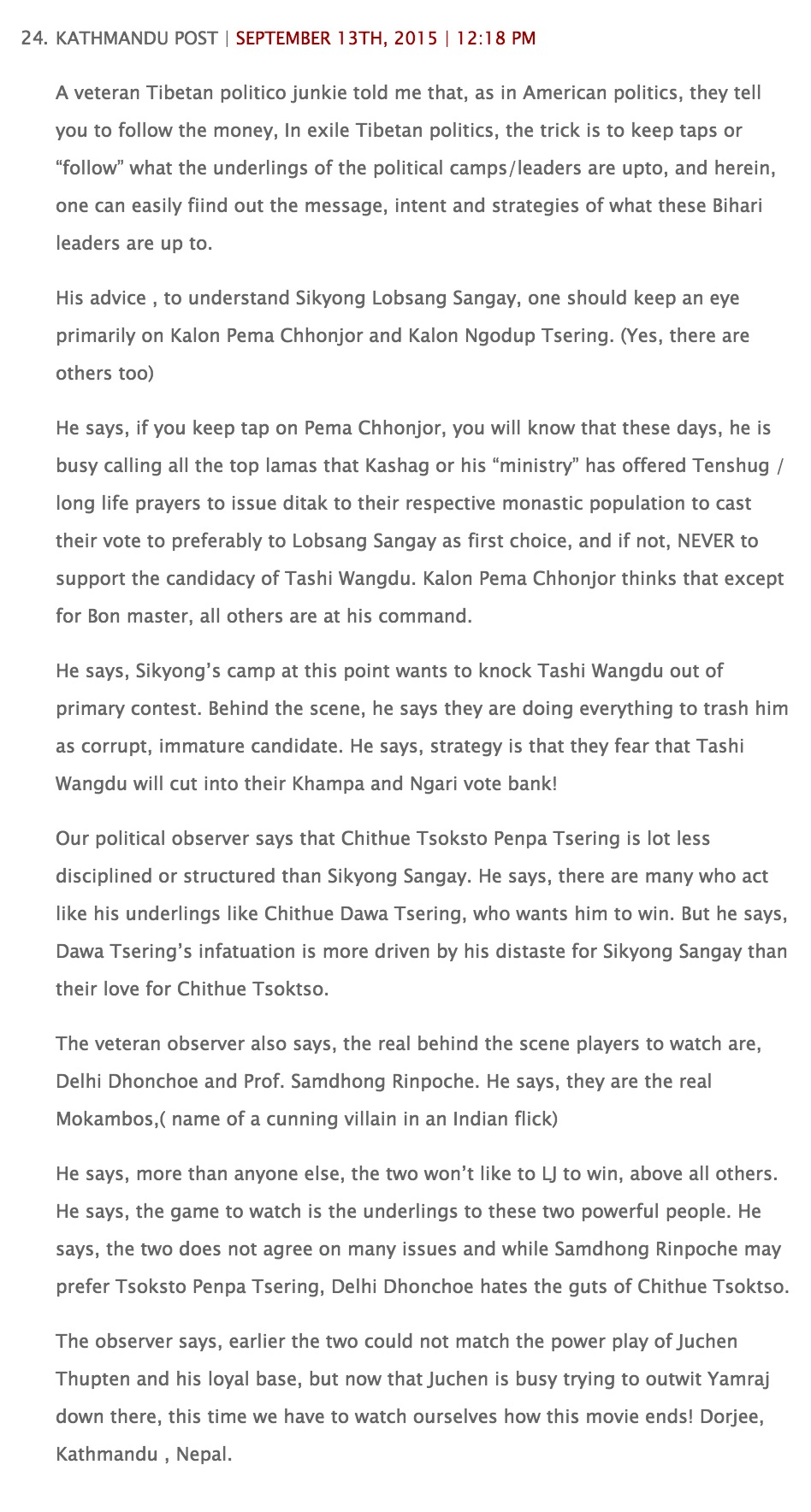
Click on image to enlarge
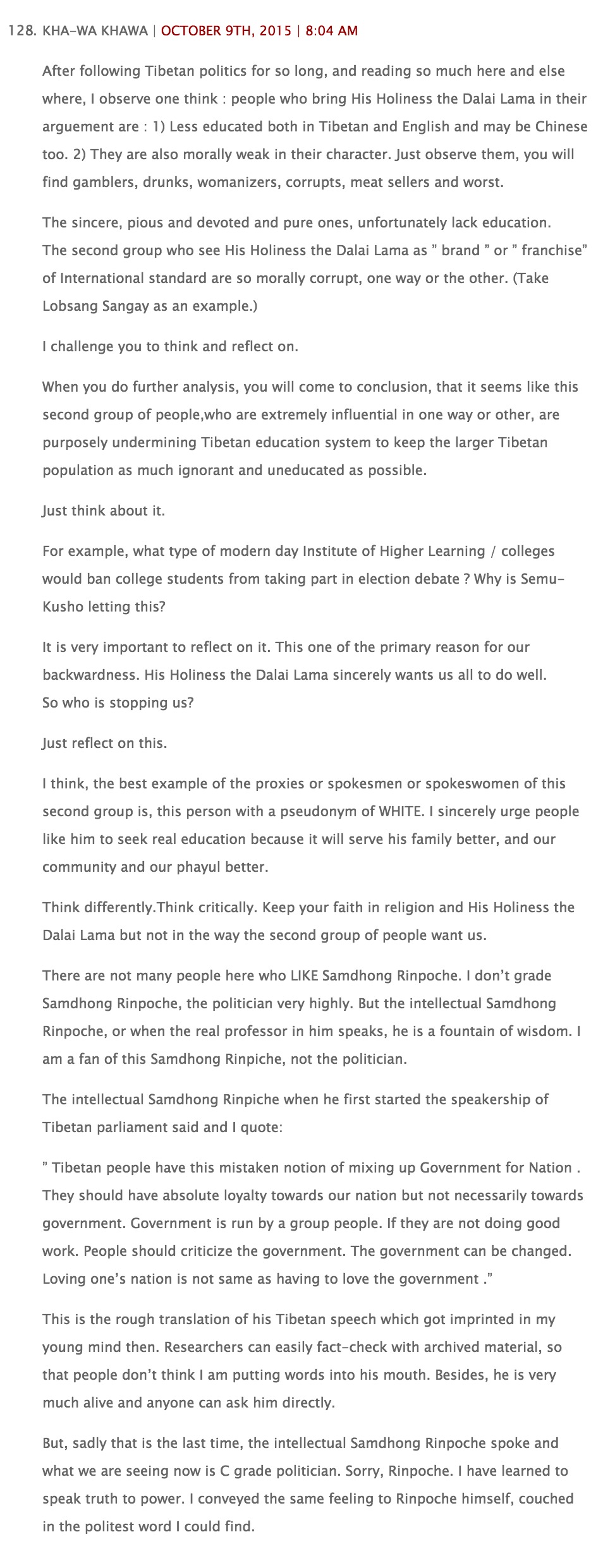
Click on image to enlarge

Click on image to enlarge
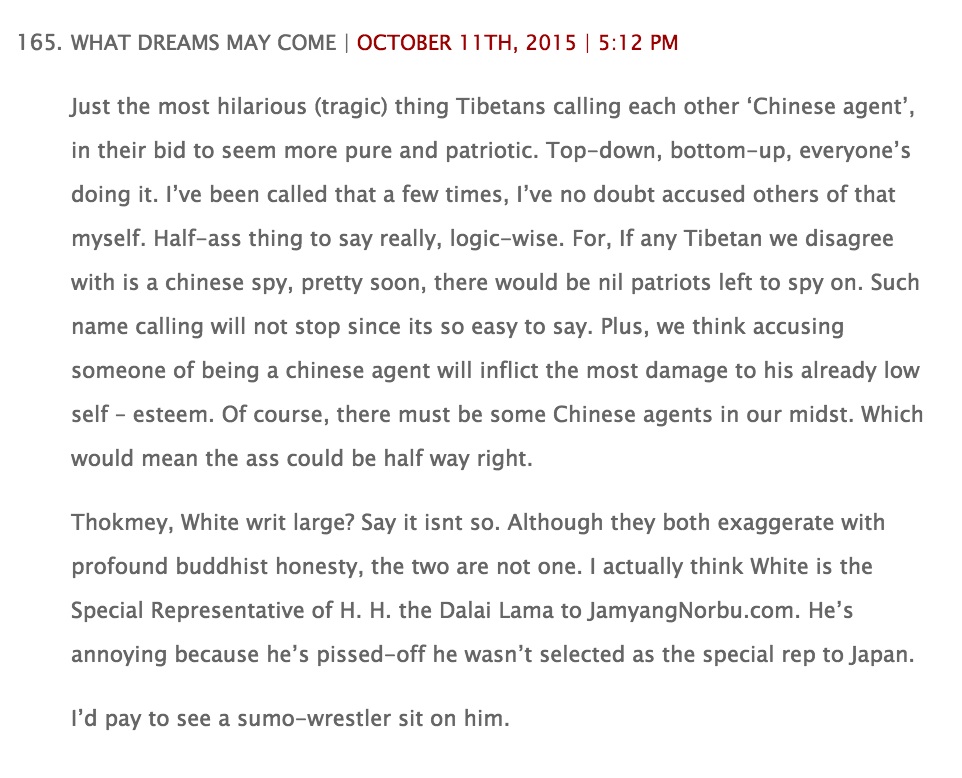
Click on image to enlarge
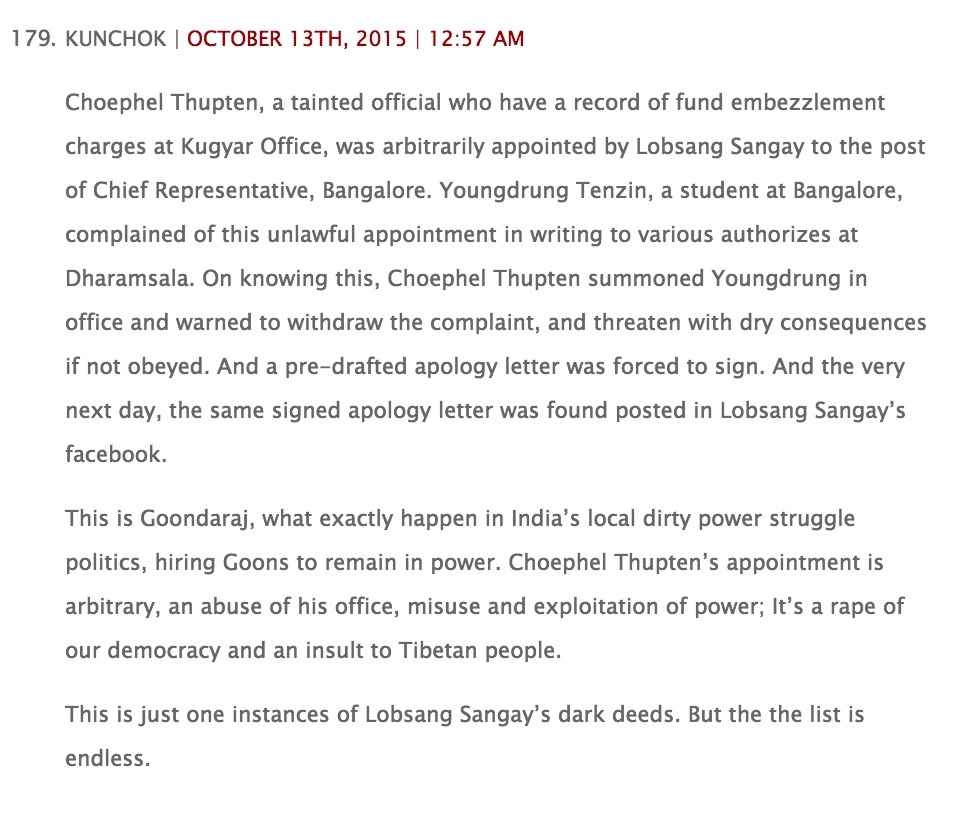
Click on image to enlarge
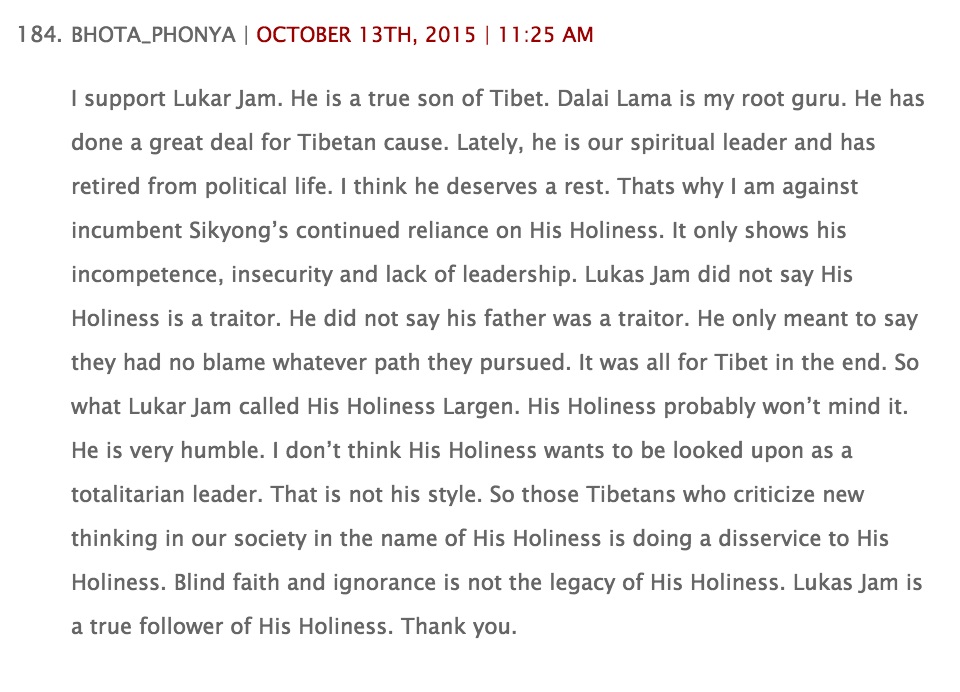
Click on image to enlarge
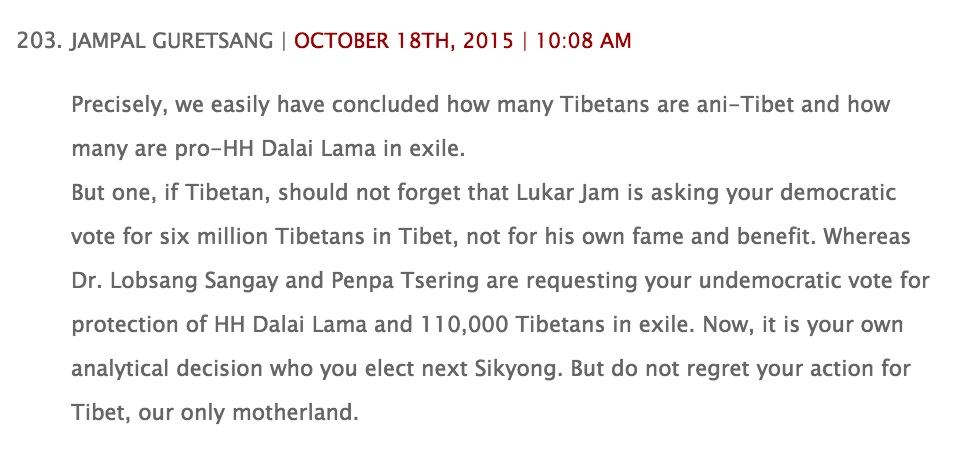
Click on image to enlarge
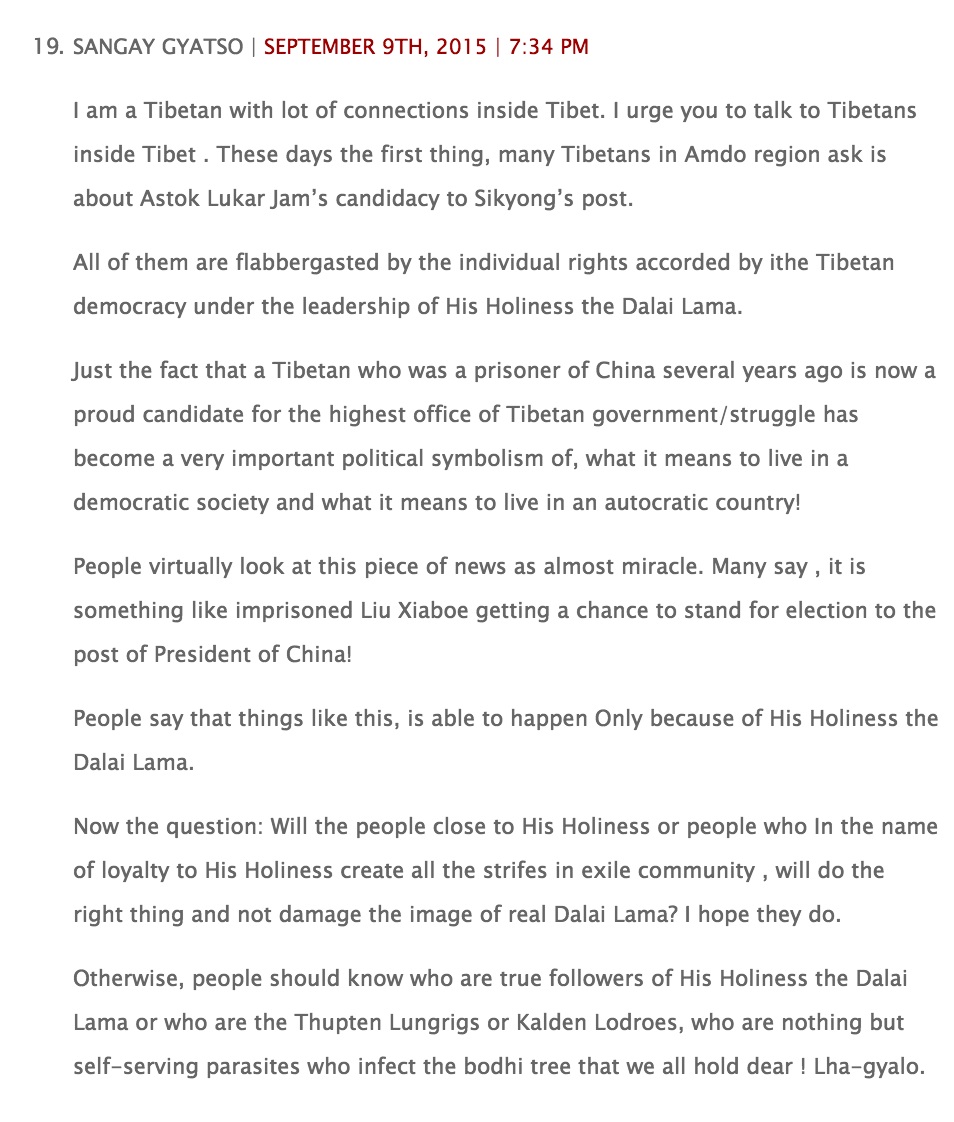
Click on image to enlarge
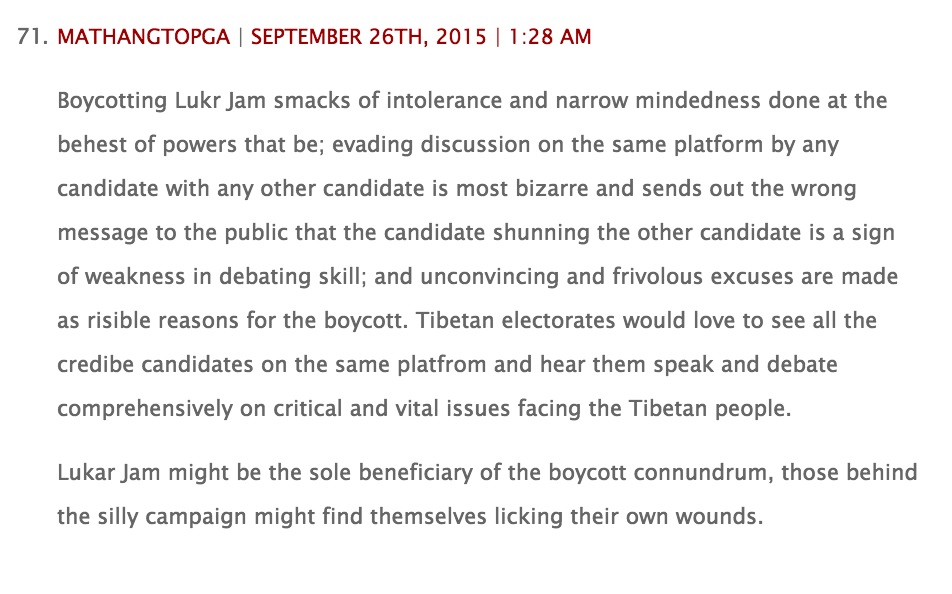
Click on image to enlarge
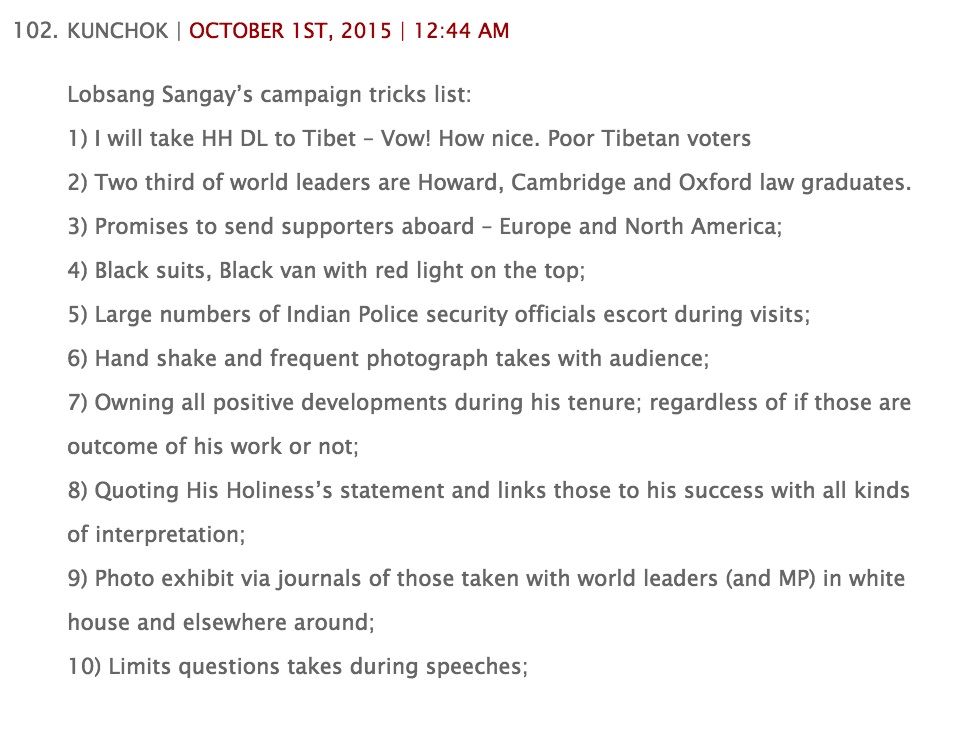
Click on image to enlarge

Click on image to enlarge
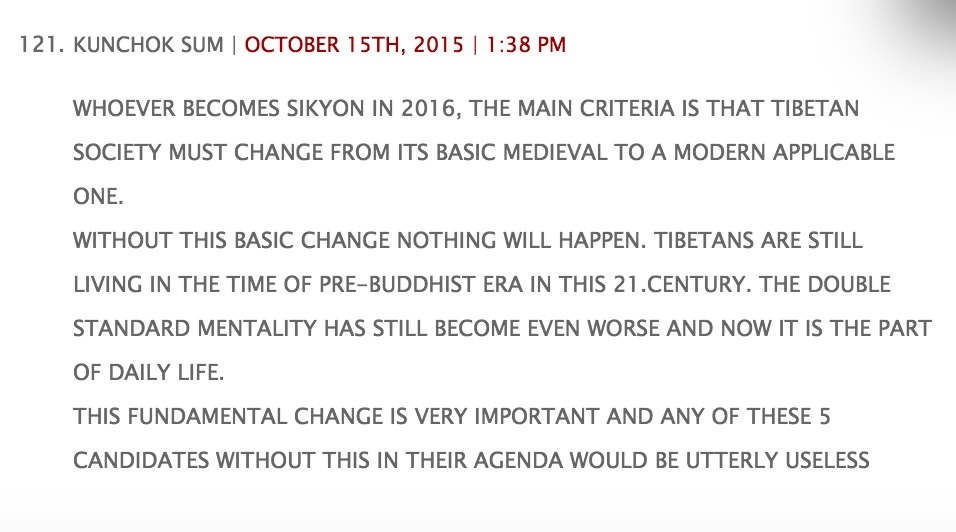
Click on image to enlarge
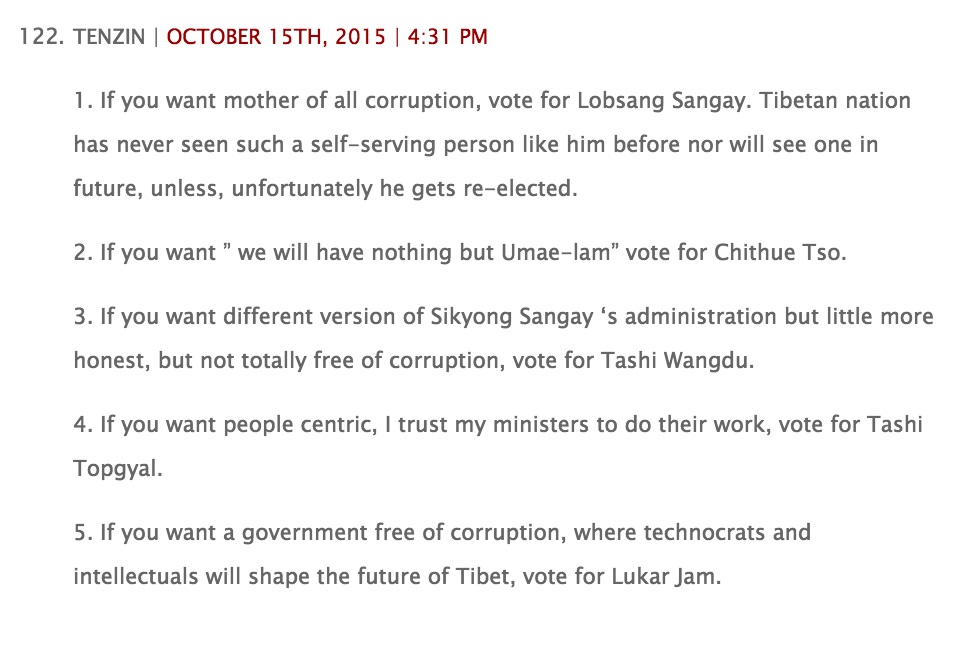
Click on image to enlarge
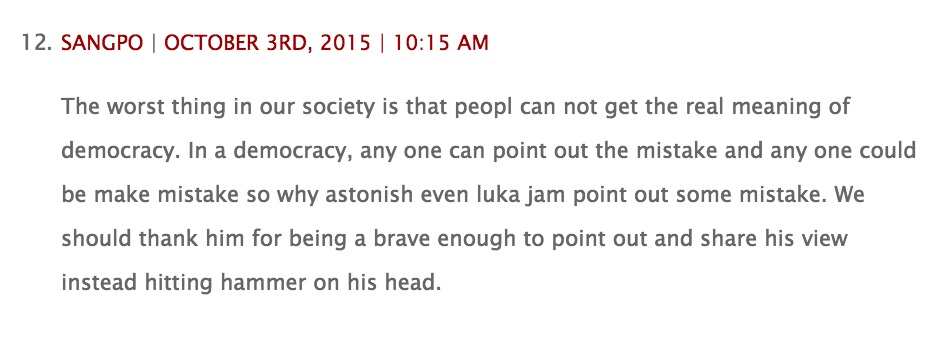
Click on image to enlarge
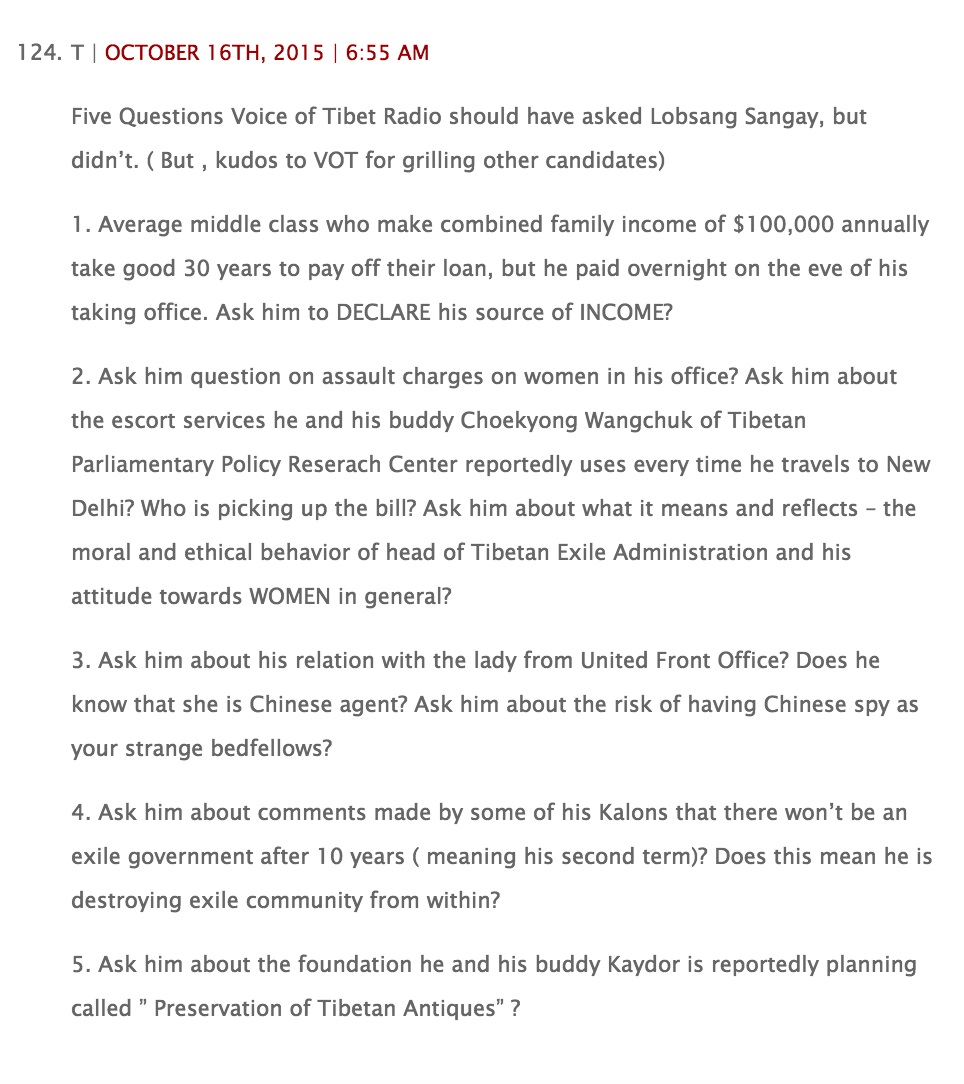
Click on image to enlarge
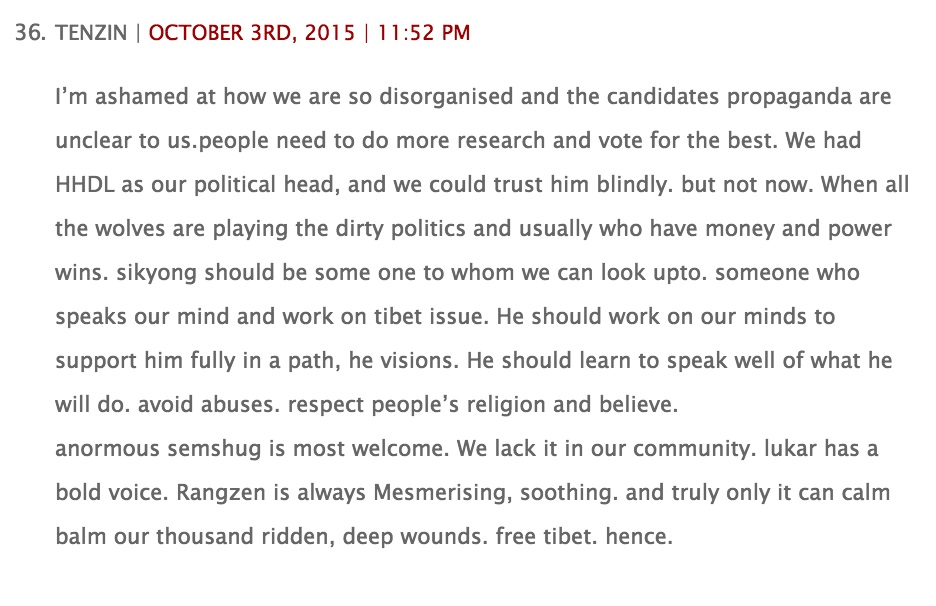
Click on image to enlarge
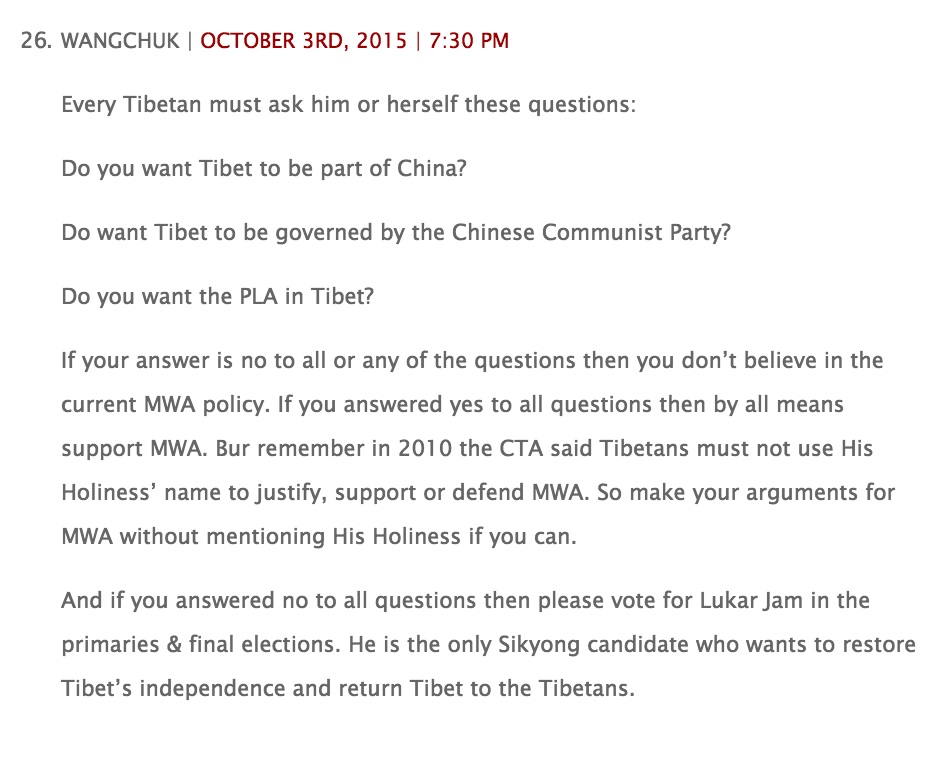
Click on image to enlarge
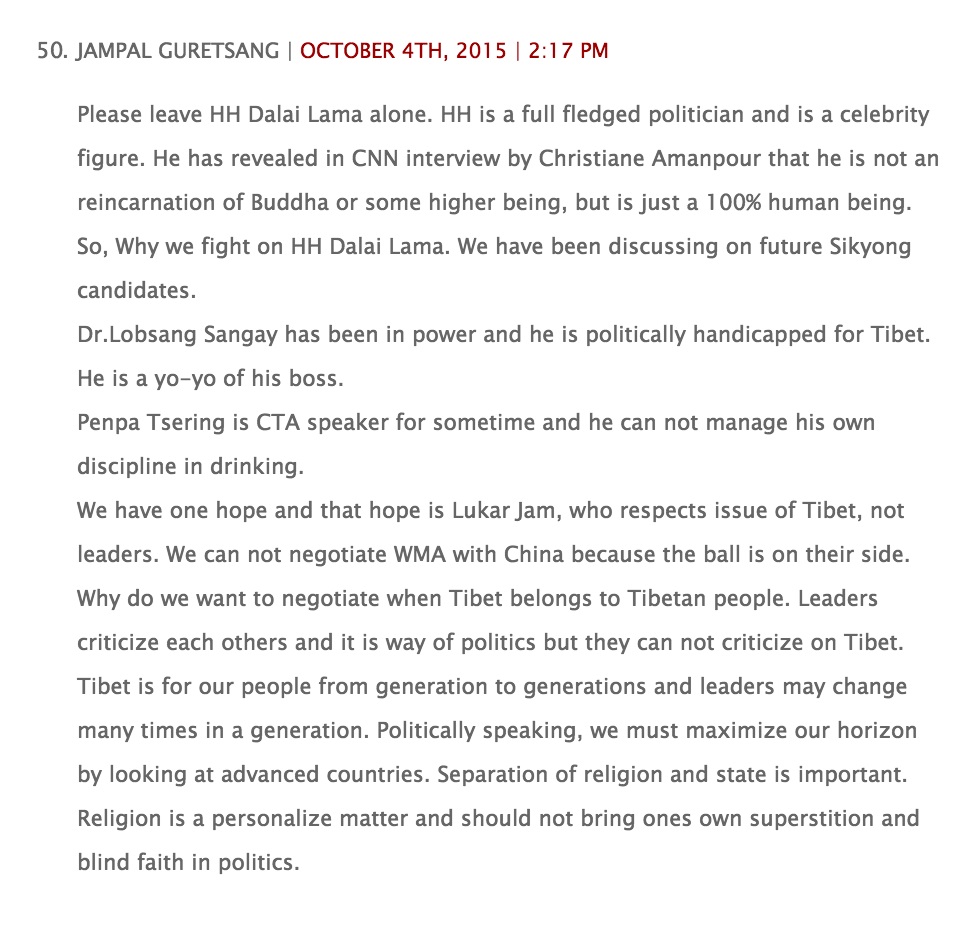
Click on image to enlarge
18. Samdhong Rinpoche
The ex-prime minister of the Central Tibetan Administration, Samdhong Rinpoche is unhappy and does not want to vote. Even their own ex-prime minister is turning against them, then followed by their very own gods. We can see how corrupted and disorganised the leadership is.
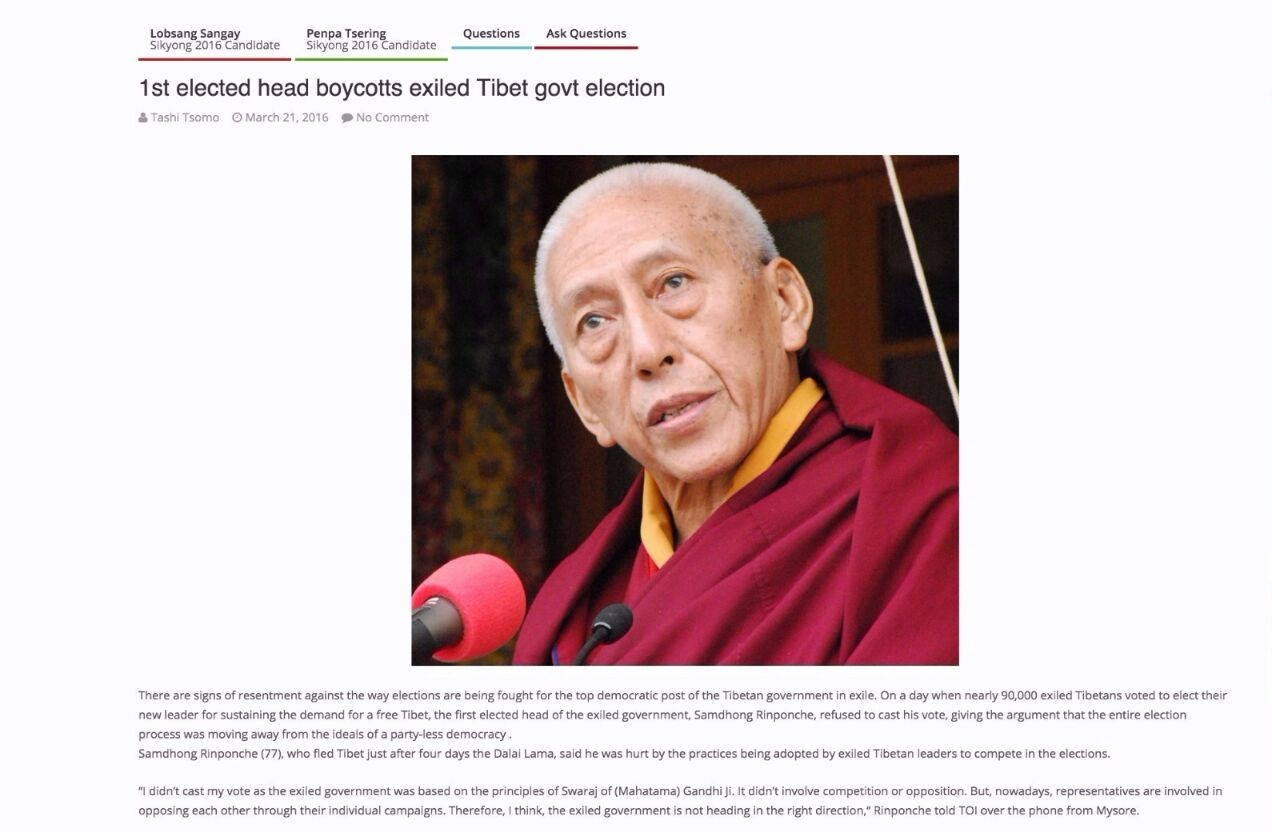
Click on image to enlarge
MORE NEWS LIKE THIS